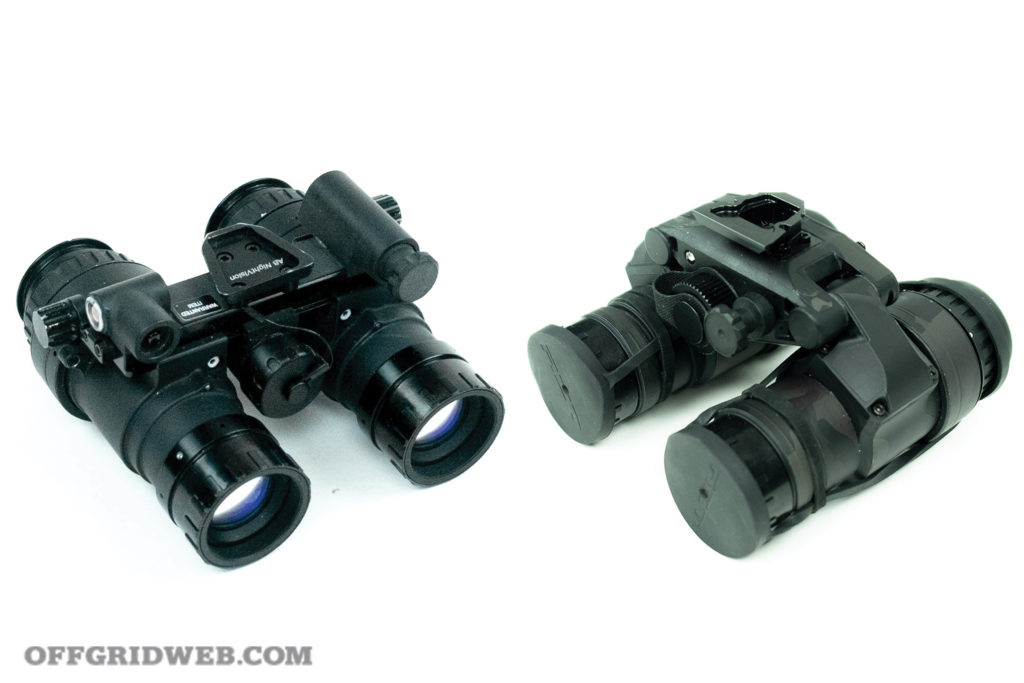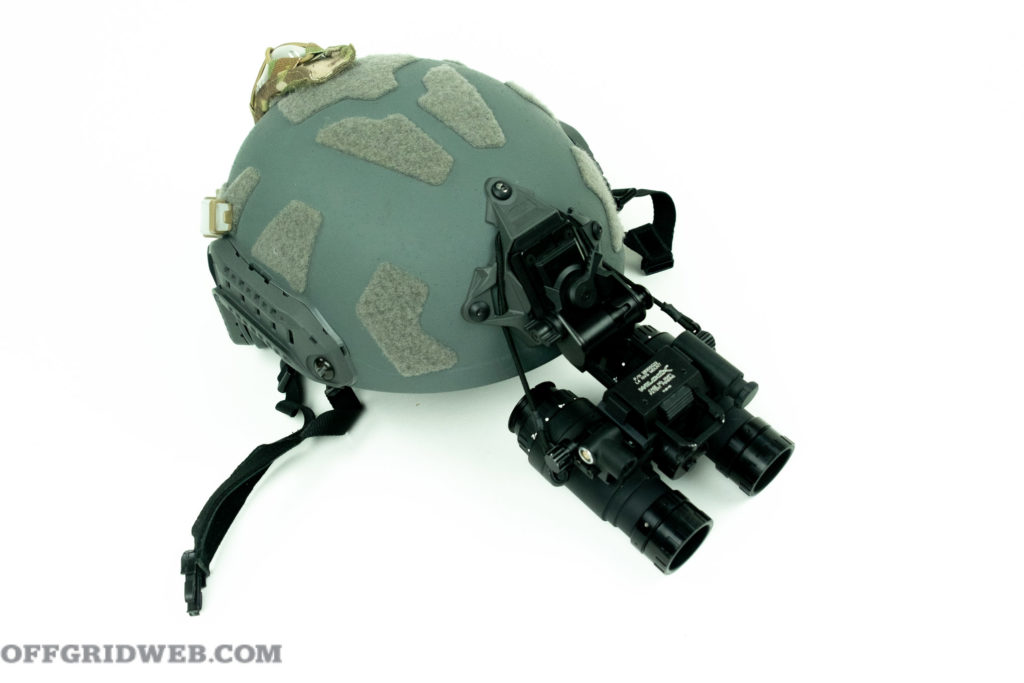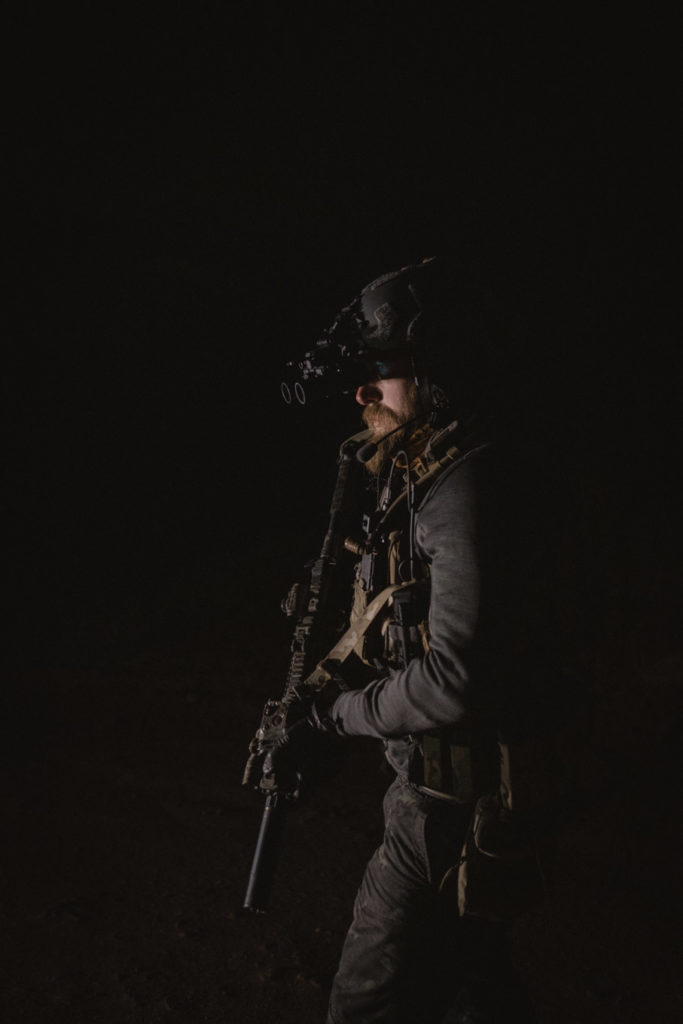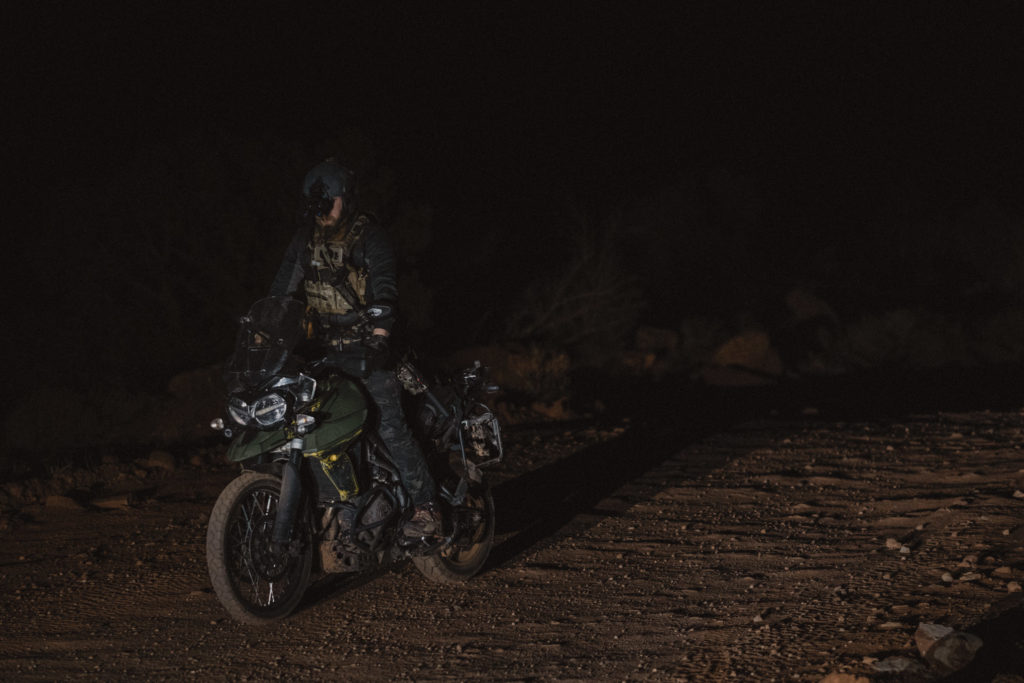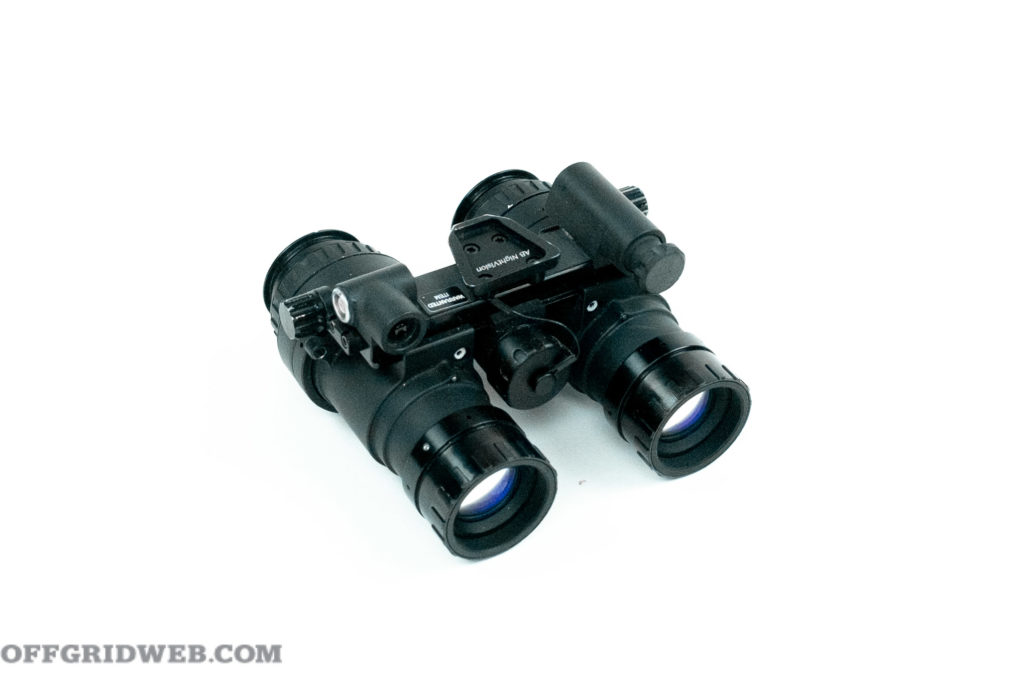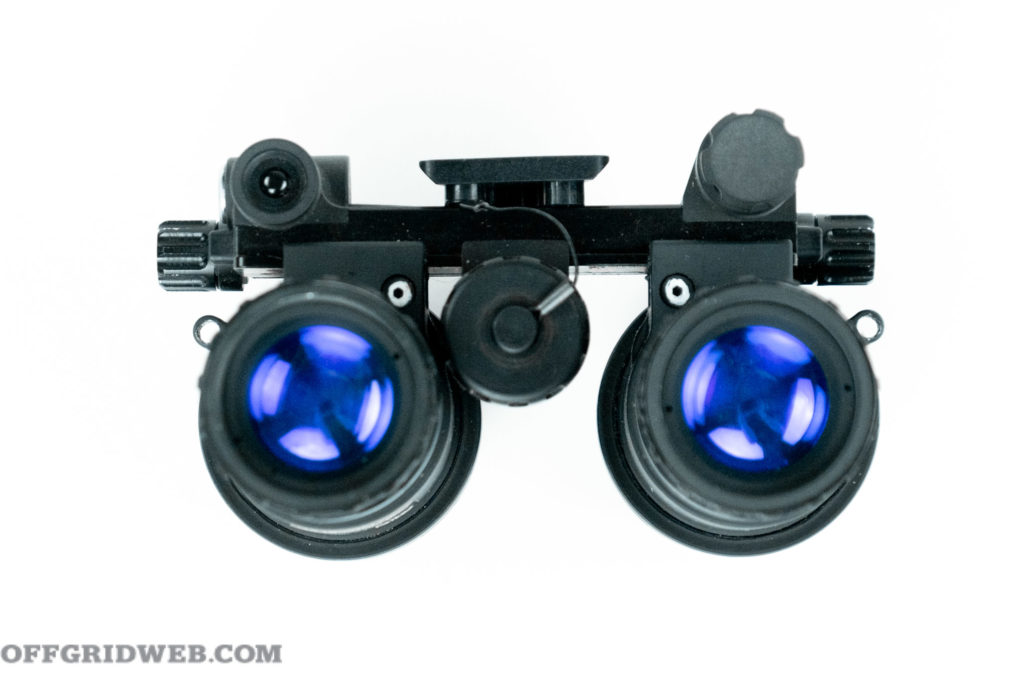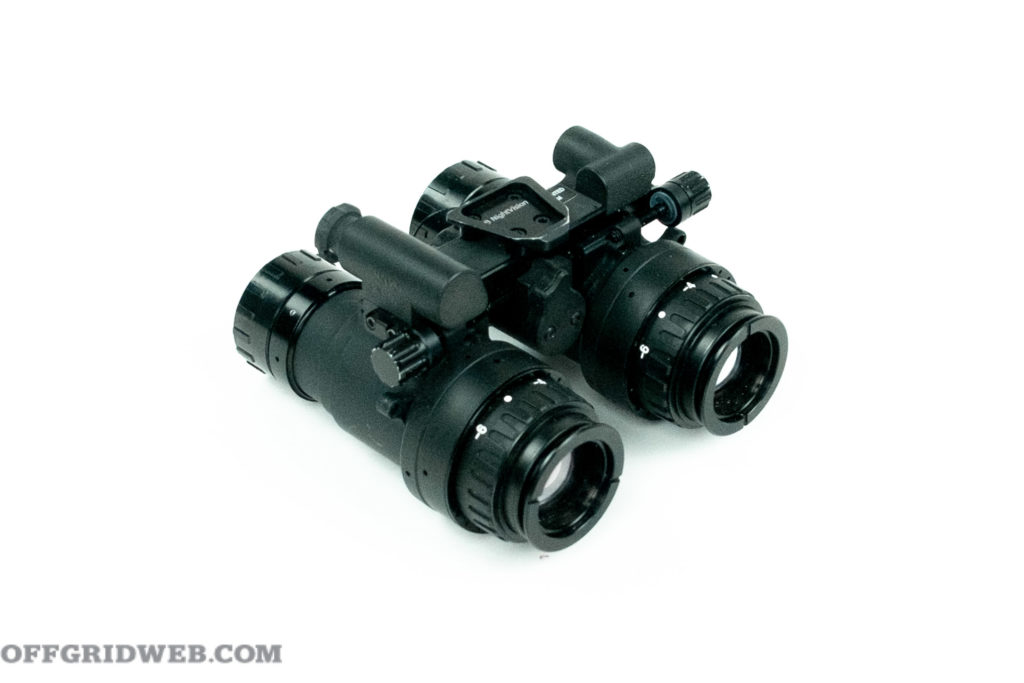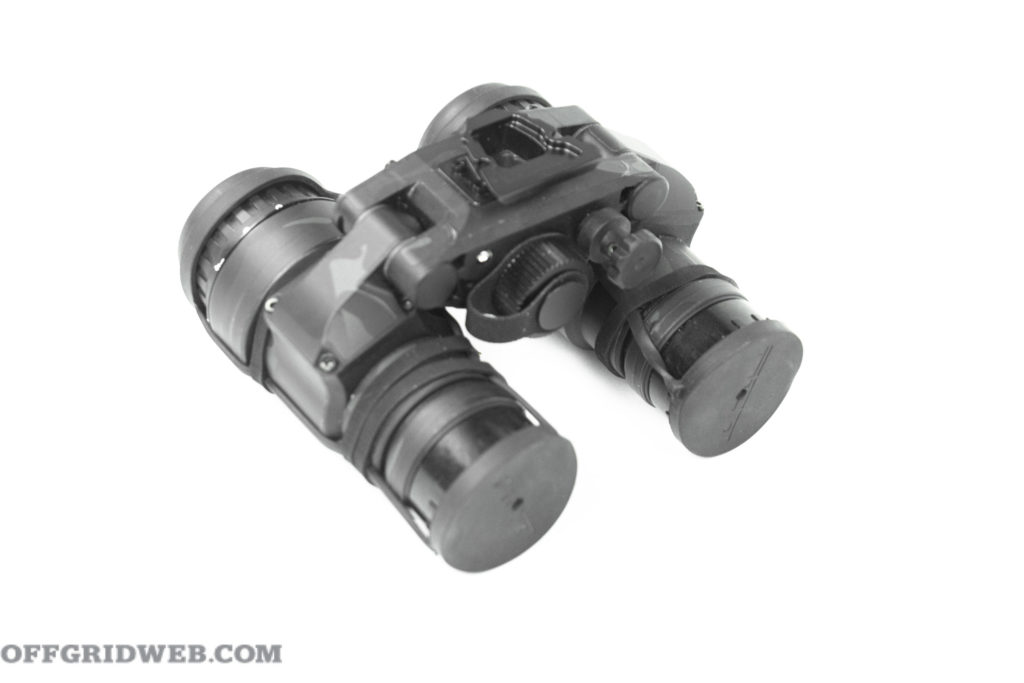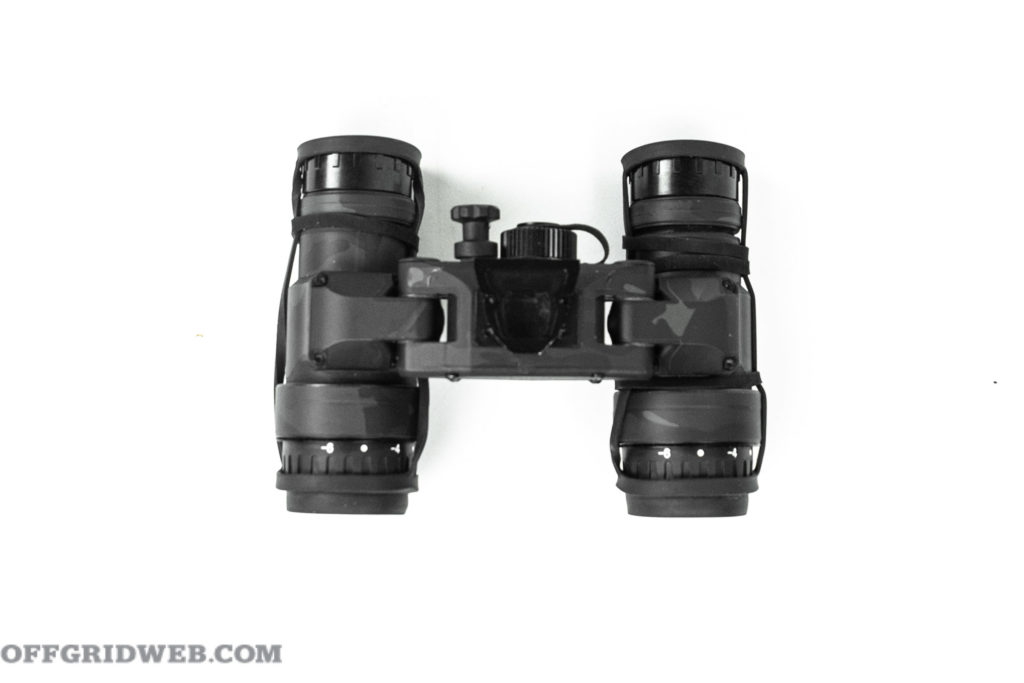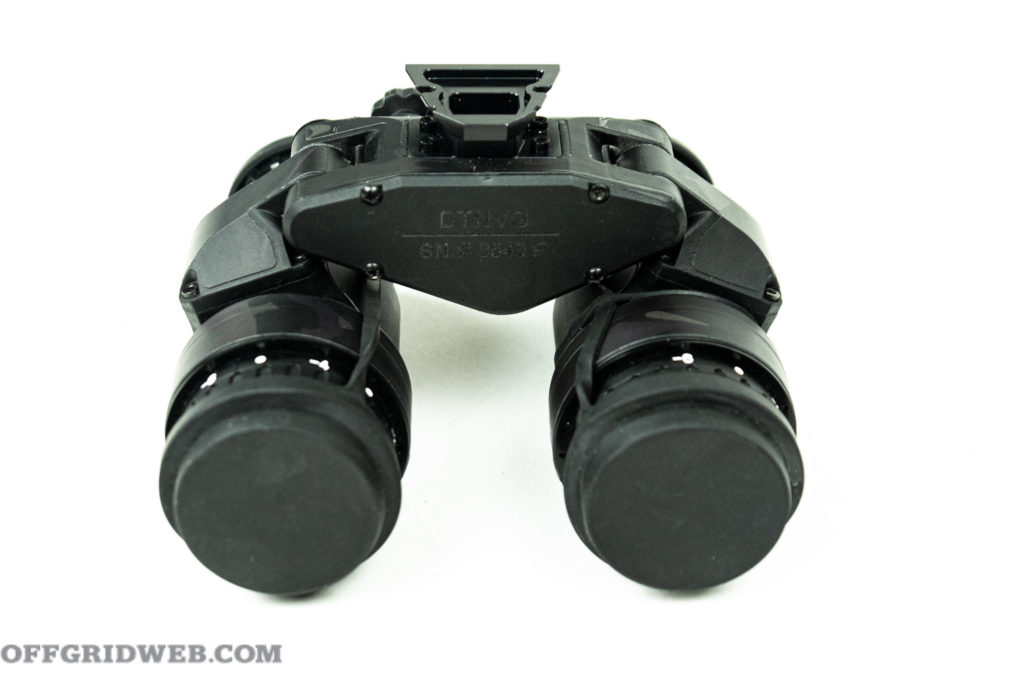In This Article
Take a look at the animal kingdom and pay careful attention to the physiology of successful predators. You’ll notice a few common threads, such as sharp claws and teeth, quick reflexes, strong muscles, and precise senses. Although some hunters rely primarily on enhanced smell, touch, and hearing, many of the most dominant species have fine-tuned vision. Eagles, for example, have eyes that are disproportionately large for their heads, with deep central foveas and extremely high rod and cone cell density. According to Live Science, an average eagle has vision four to five times more precise than a human’s, in addition to vastly improved low-light acuity and color perception — they can see parts of the color spectrum we can’t, including ultraviolet light. So, it’s no surprise that these birds can ambush prey from high above with pinpoint accuracy.
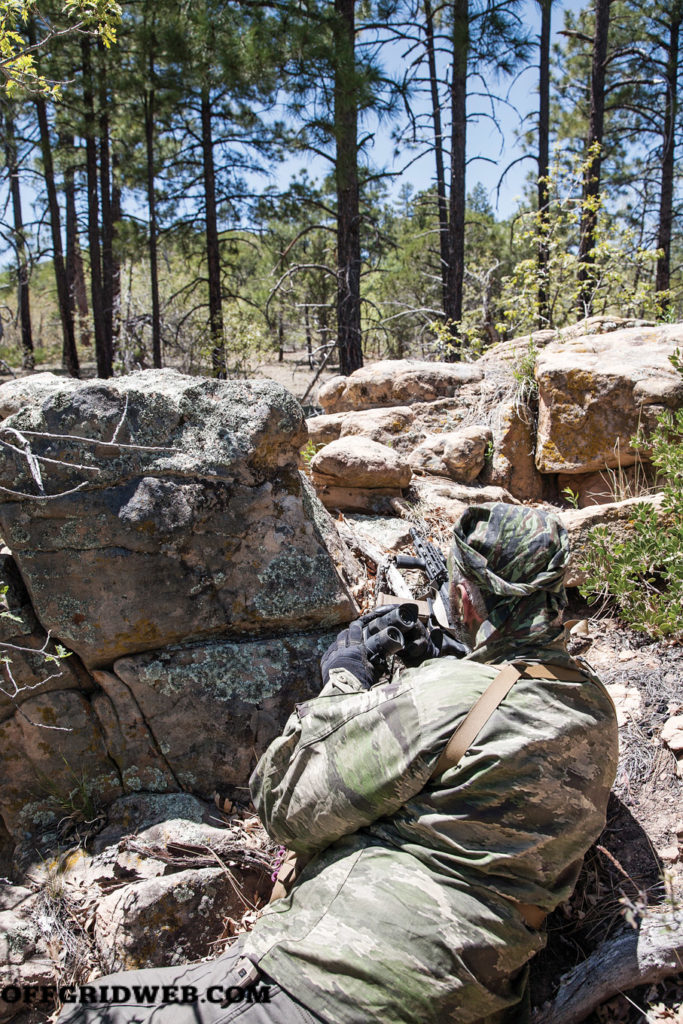
Although we use the term “eagle-eyed” to describe humans with outstanding vision, our eyes can’t possibly compete with those of a real eagle. Thankfully, we have something other animals don’t: The ability to improve our senses through tools and technology. For thousands of years, we’ve been using glass lenses to create optical magnification devices that let us see faraway objects — ships on the horizon, enemy troops on the battlefield, and prey to hunt. Many of the early devices were single-tube monoculars, but we quickly learned that dual-tube binoculars gave us a wider and clearer view.
In this article, we rounded up six pairs of binoculars from a wide range of price points. To level the playing field, each was selected in a common and versatile 10×42 binoculars size. But before we proceed, we should clarify some important terms you’ll see throughout this article.
Optical Terminology
Like rifle scopes, binoculars are described in terms of magnification and objective lens diameter — in this case, all our binos feature 10x magnification and 42mm objective lenses. Larger objective lenses increase the size and weight of your binoculars, but they offer much better light-gathering capabilities, meaning that the image you see will appear bright and vibrant. The quality of that glass will determine image sharpness, as well as the degree of chromatic aberration — much like looking at an old anaglyph 3D image without wearing red and blue glasses, chromatic aberration makes colors look slightly misaligned. 10×42 Binoculars offer plenty of magnification for a variety of tasks, including target shooting, hunting, and surveillance. The 42mm size is reasonably portable, but still performs well in twilight or overcast conditions.
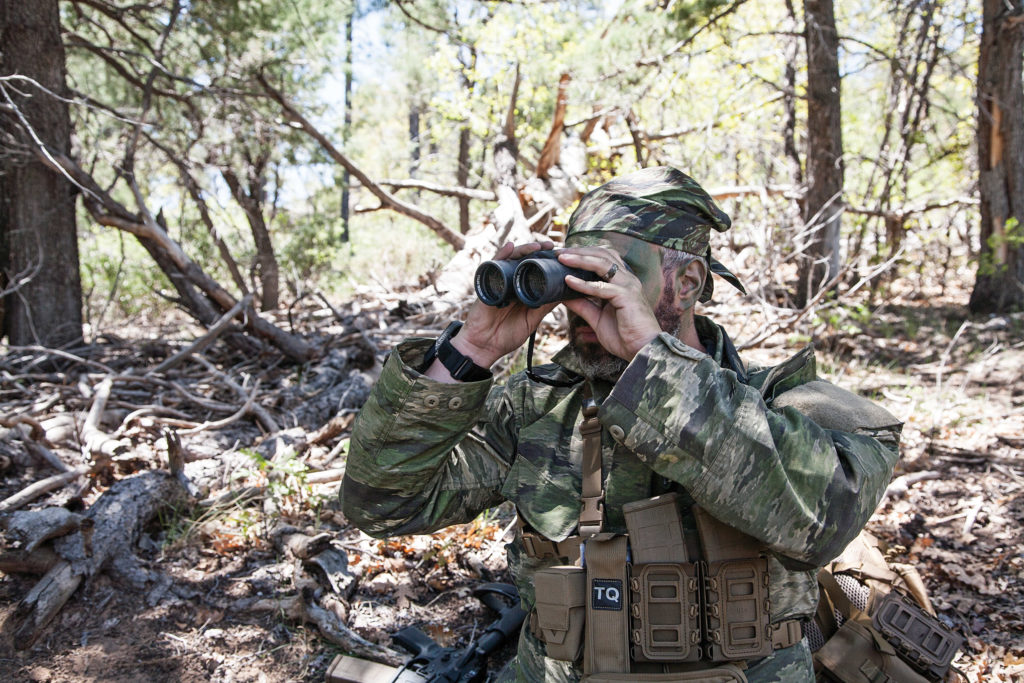
Here’s an overview of some of the other key terms, and why they matter:
Diopter
Binoculars feature diopter adjustment to compensate for slight differences between your two eyes. After calibrating the diopter, each side of the binocular should appear equally clear, and you’ll be able to use the main focus knob to bring a target into perfect focus.
Field of View (FOV)
The width of the area you can see through the lenses, denoted in either angular (e.g. 6.2 degrees) or linear (e.g. 326 feet at 1,000 yards) format. Wider FOV means you’ll have better peripheral vision around your target. For the sake of comparison, we provided all FOV ratings in imperial units (feet at 1,000 yards) as opposed to metric (meters at one kilometer) or degrees.
Eye Relief
The distance your eye must be from the eyepiece to see the complete image, without a dark vignette effect around the edges. A higher number means your eyes can be further away without distortion; this is especially important if you wear glasses, since you may be unable to hold the binoculars close to your eyes. Adjustable eyepieces allow you to dial in the appropriate eye relief without holding the binoculars further away from your face.
Exit Pupil
A number calculated by dividing objective lens size by magnification power. Since all binoculars in this article are 10x42mm, all pairs have an exit pupil measurement of 4.2mm. Lower magnification and higher lens size (e.g. 7x50mm) produce larger exit pupil values, which allows more light to pass through the binoculars. In bright settings, your pupils will already be smaller than this exit pupil size, so this value matters most in low-light settings.
Interpupillary Distance (IPD)
This is a measurement of the distance between the pupils of your eyes, which can be obtained from your optometrist. You can also get a ballpark measurement at home by holding a metric ruler against your forehead in front of a mirror. In order to see a full image through your binoculars, you’ll need them to articulate enough to match your IPD. For most adults, that’s between 50mm and 75mm; women tend to be lower in this range, and children can be 40mm or less. Most binocular makers don’t advertise their exact IPD adjustment range; those that do typically go from mid-to-high 50s to mid 70s. You may need to try a few pairs firsthand if you have a very narrow or wide face, or if you plan to let your kids use them.
Miscellaneous Terms
Lastly, we’ll note that all binoculars in this guide are “fully multi-coated,” which means that each glass surface has been treated with multiple coating layers to diminish glare and enhance clarity. Less expensive binoculars may use single-layer coatings, or may not coat every piece of glass. All binoculars in this article are also waterproof sealed to block dust and moisture from entering the housing; three of the pairs are nitrogen-purged to further reduce the risk of fogging in extreme conditions. All pairs are also tripod-compatible.
Bushnell Nitro 10×42
Dimensions: 6 by 4.2 by 2.5 inches
Weight: 1.7 pounds
FOV: 340 feet at 1,000 yards
Eye Relief: 17 millimeters
MSRP: $350
URL: bushnell.com
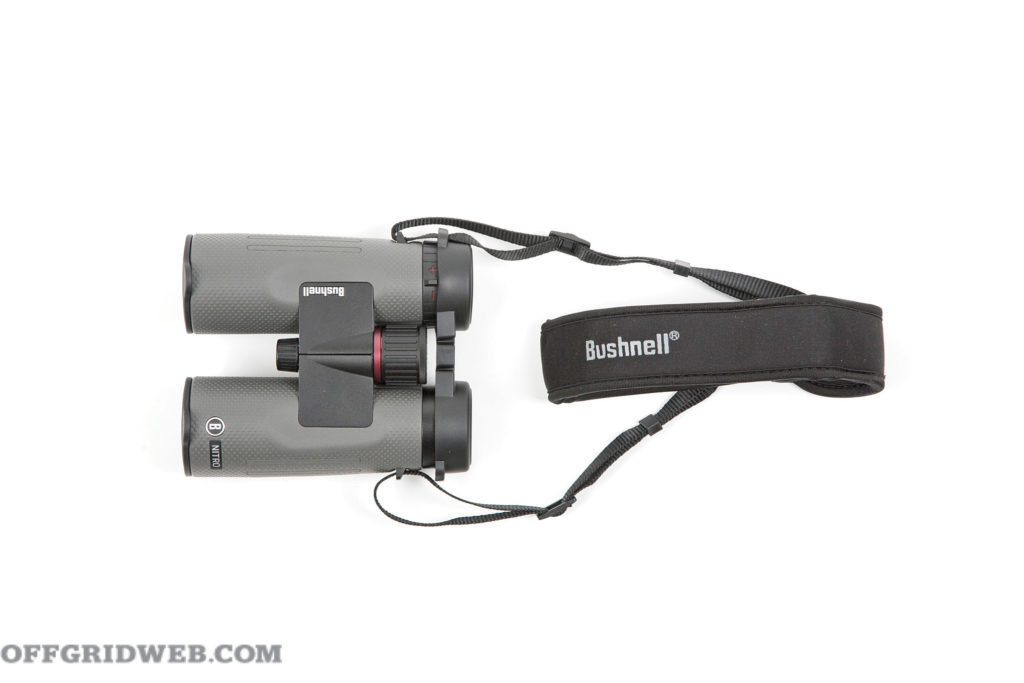
Aesthetically, these Nitro binoculars immediately caught our eye. Their gunmetal gray housing is thoroughly textured, and features silver accents and a red anodized trim ring. The lens and eyepiece caps fit well and feel secure. A nice, molded foam case is also included, along with a padded neck strap and clip-on Spudz cleaning cloth (a handy range bag accessory). Beneath the surface, these binos are said to use “Bushnell’s highest-quality glass,” but the sharpness and color fidelity of the ED Prime glass didn’t blow us away. That said, it’s good for this price range. The glass is coated with an EXO Barrier to reject water, oil, dust, and scratches, and the prisms are coated in PC-3 Phase Coating to boost contrast. Given the name, we thought these might be nitrogen-purged — a feature usually seen only on high-end models — but that doesn’t appear to be the case.
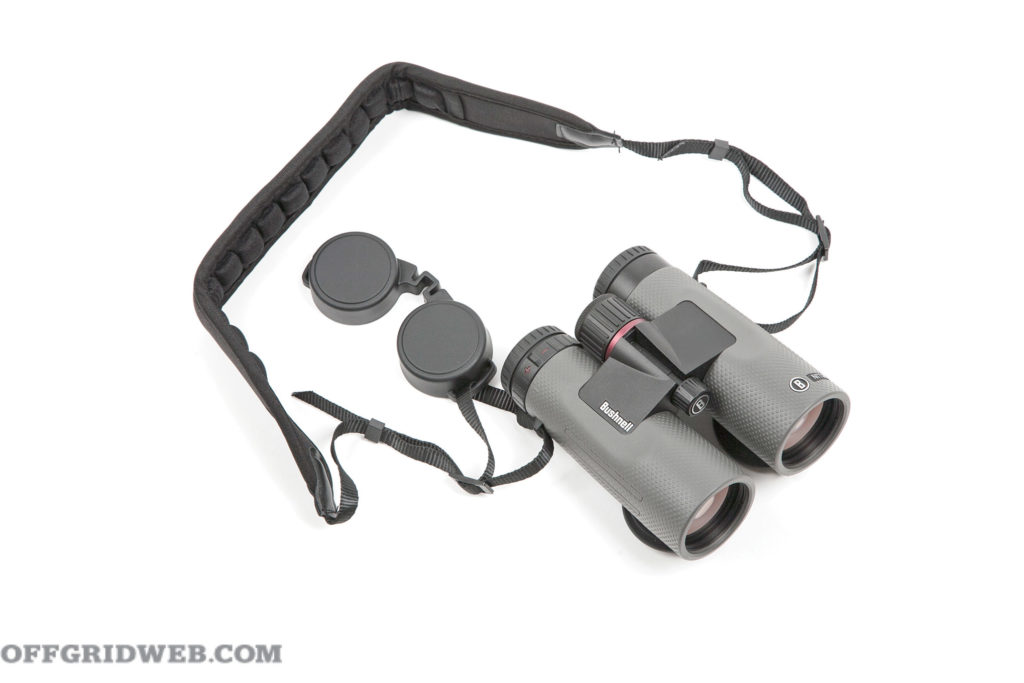
Pros
- Wide FOV and relatively long eye relief are great for glasses-wearers.
- Best diopter adjustment design of the bunch, with a raised indicator tab and locking mechanism
- The housing and accessories look and feel high-quality, despite the affordable price.
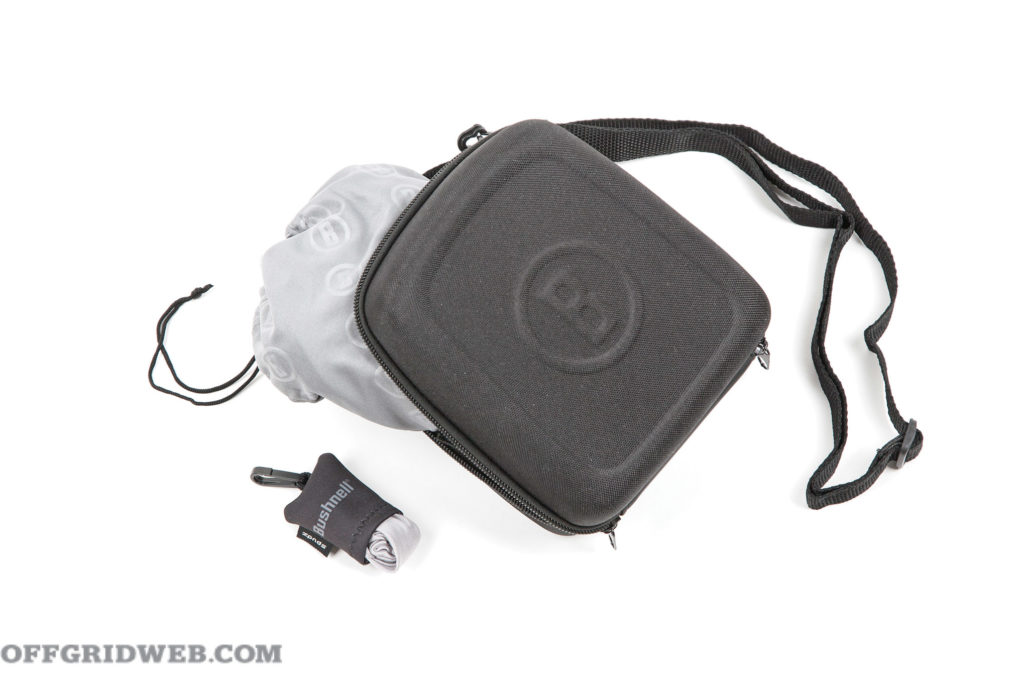
Cons
- Clarity isn’t perfect, with mild chromatic aberration on highlights and blur near the edges.
- “Nitro” name may lead to confusion about nitrogen-filled optics
Leupold BX-4 Pro Guide HD 10×42
Dimensions: 6 by 4.7 by 2.5 inches
Weight: 1.7 pounds
FOV: 326 feet at 1,000 yards
Eye Relief: 16 millimeters
MSRP: $500
URL: leupold.com
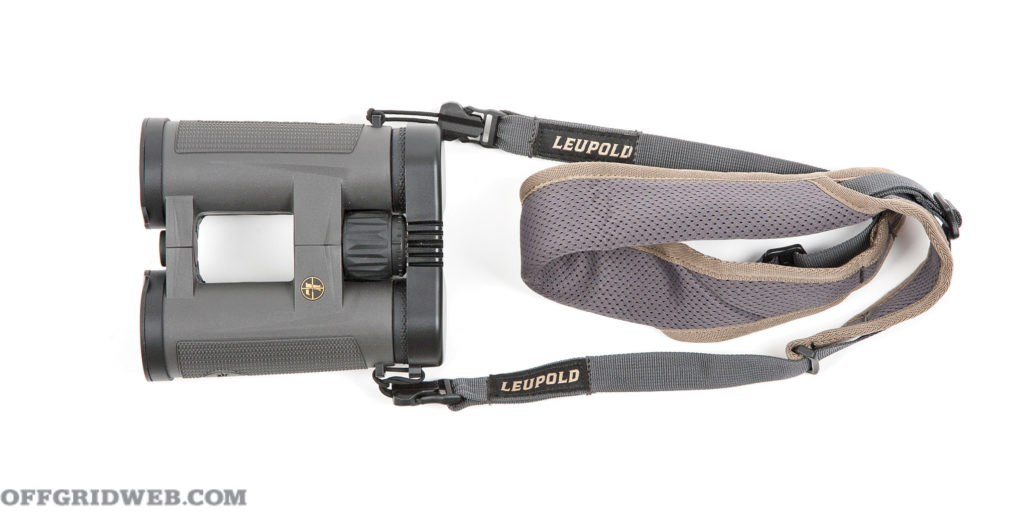
Leupold calls these binoculars a “Jack of all trades,” with sufficient power and FOV for a variety of uses. The open-bridge housing has two points of contact for added strength, and features a grippy Armor coating with textured areas for each palm. Under the hood, Extra Low Dispersion glass objective lenses have been used to reduce chromatic aberration. This glass is coated in Guard-Ion for water- and dust-resistant properties, as well as Diamondcoat 2, which enhances abrasion-resistance and light-transmission. The prisms are phase coated for edge-to-edge sharpness. The focal ring is nice and smooth, but the tight diopter adjustment is difficult to dial in while looking through the lenses. Also, the eyepieces feature twist-adjustment, but don’t like to stay put. Leupold’s cushy neck strap and compact carrying case were our favorites in this roundup, but we noticed the loose front covers tend to slip off as the binos are removed from the case.
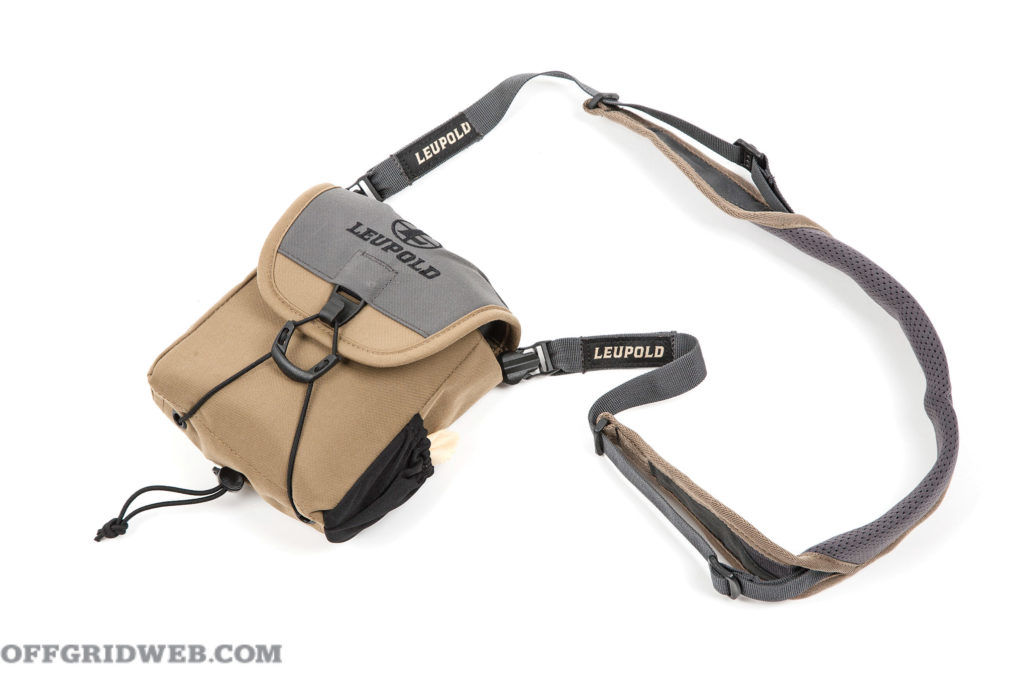
Pros
- Crisp image with minimal chromatic aberration
- High-quality case with MOLLE-compatible snaps and comfy neck strap
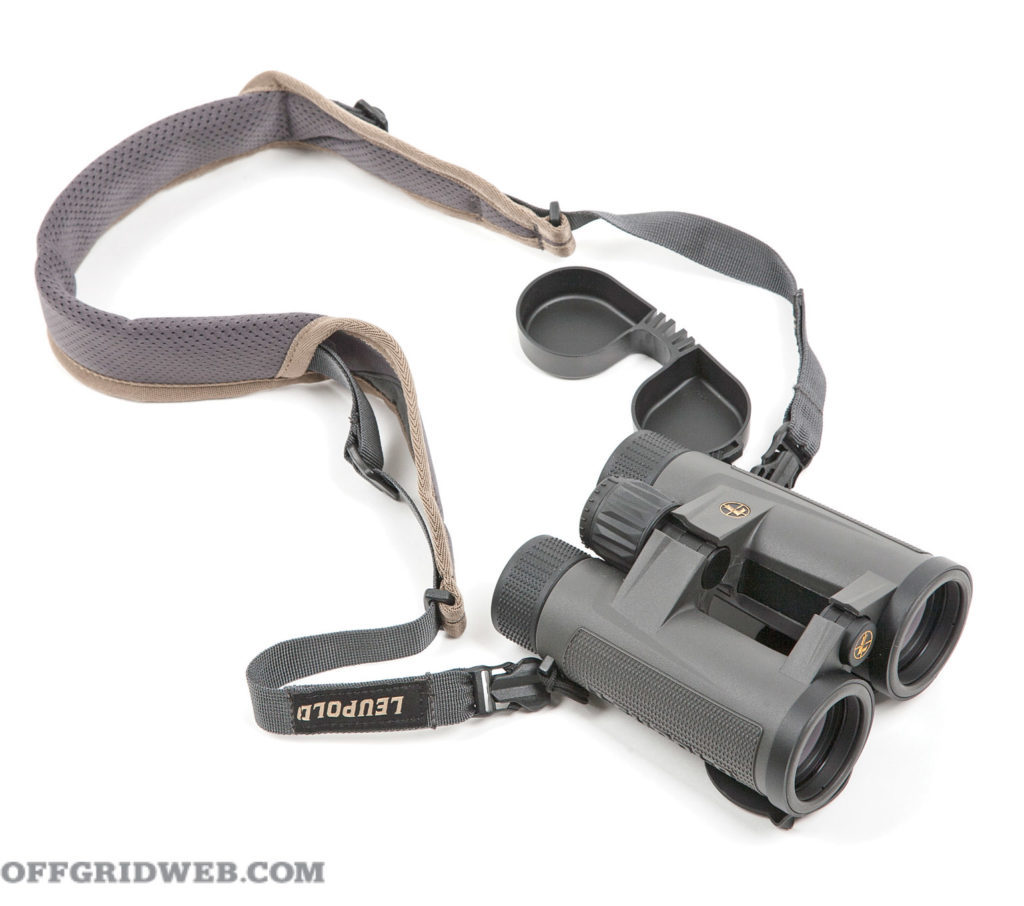
Cons
- Slim rubber front covers are easily dislodged and misplaced
- Diopter adjustment is very tight, but eye cup adjustment is too loose.
- 58mm minimum IPD setting may be too wide for some users
Meopta MeoPro Optika LR 10×42
Dimensions: 6 by 4.5 by 3.2 inches
Weight: 2.3 pounds
FOV: 325 feet at 1,000 yards
Eye Relief: 17 millimeters
MSRP: $1,500
URL: meopta.com
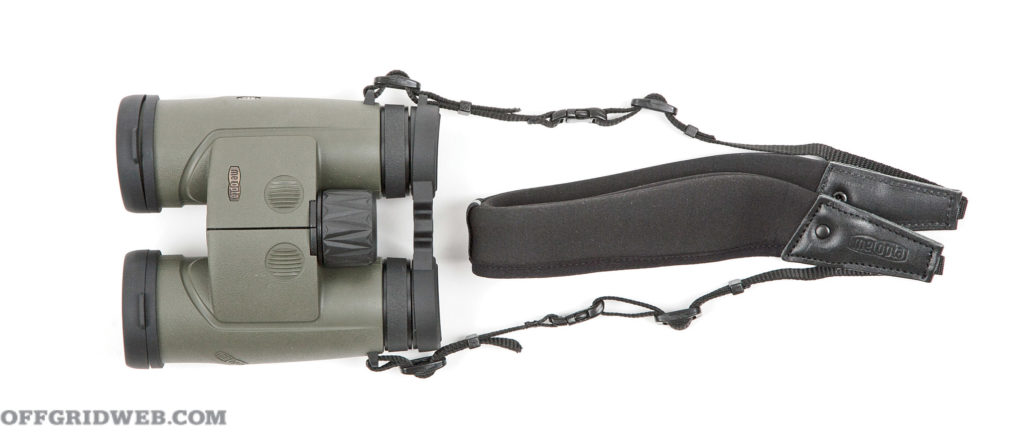
One of Europe’s most prolific optic manufacturers, Meopta was founded in 1933 in what is now the Czech Republic. Over the decades, the company has produced everything from aerospace equipment and movie projectors to riflescopes and binoculars. New for 2021, the Optika LR combines premium glass with an integrated laser rangefinder. Just press a button on the housing, and an OLED target ring appears; press again to show a digital readout of the distance to your target (yards or meters). A second readout shows your choice of incline angle, height difference, or horizontal difference readings. Tech aside, the image quality is gorgeous, thanks to the HD Fluoride glass and proprietary MeoLux coating that provides 85-percent light transmission. All lenses are also coated in MeoDrop hydrophobic coating, and the magnesium housings are purged with dry nitrogen to block even the slightest trace of condensation.
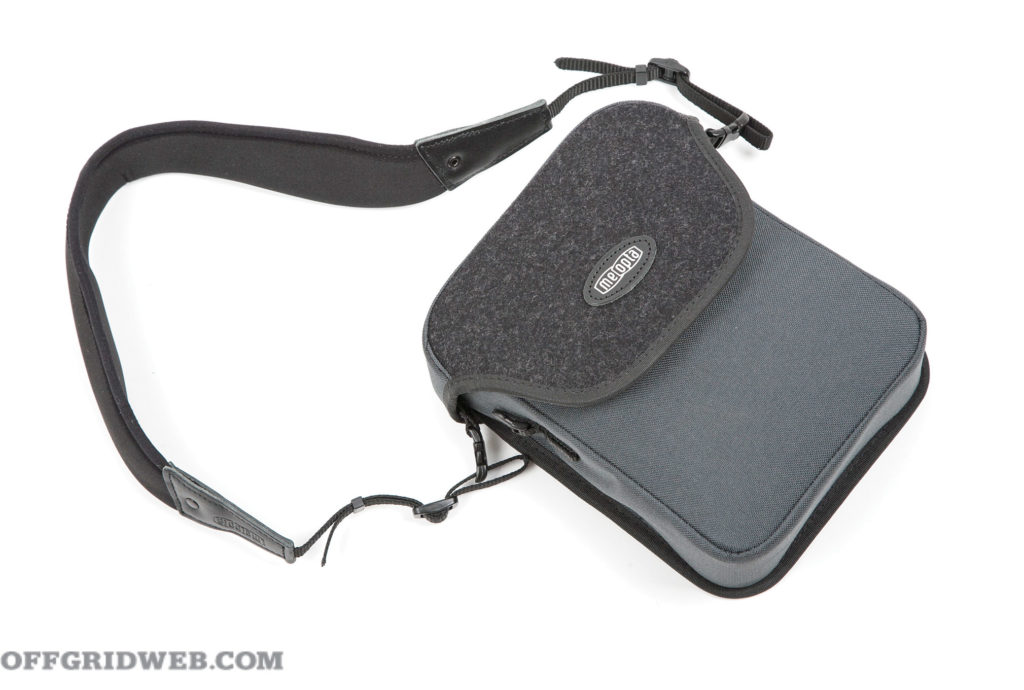
Pros
- Impressive clarity and brightness throughout the entire field of view
- Laser rangefinder is a great tool for target practice, zeroing optics, hunting, competition, and professional applications
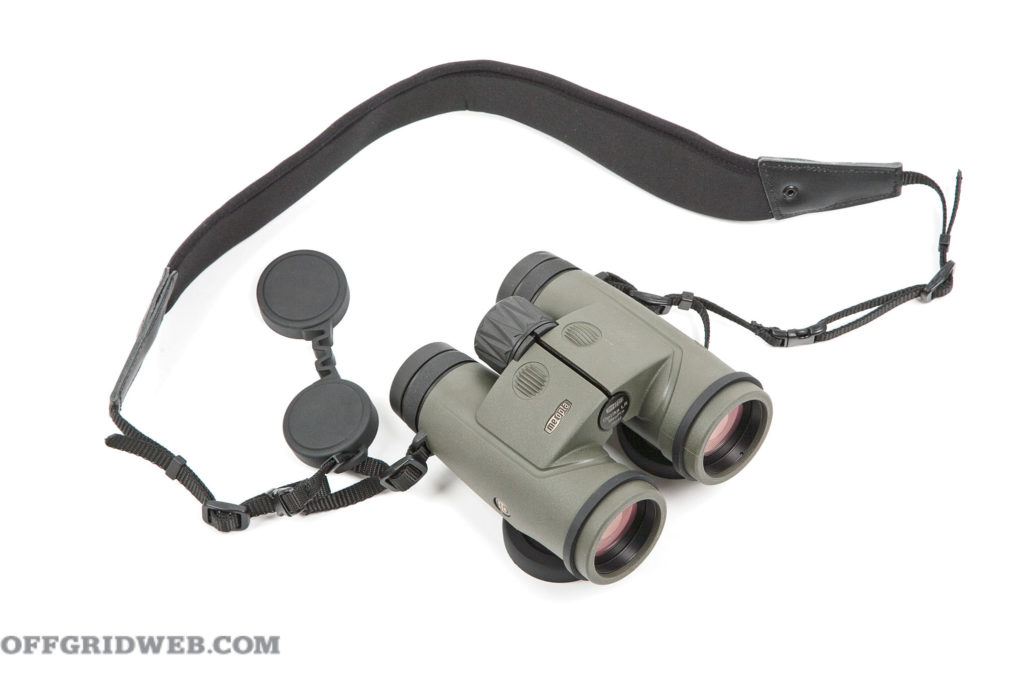
Cons
- Although the rangefinder and high-quality glass don’t have much effect on size and weight, they certainly drive up the price.
Riton X5 Primal 10×42 HD
Dimensions: 5.7 by 4.5 by 2.7 inches
Weight: 1.7 pounds
FOV: 315 feet at 1,000 yards
Eye Relief: 15 millimeters
MSRP: $600
URL: ritonoptics.com
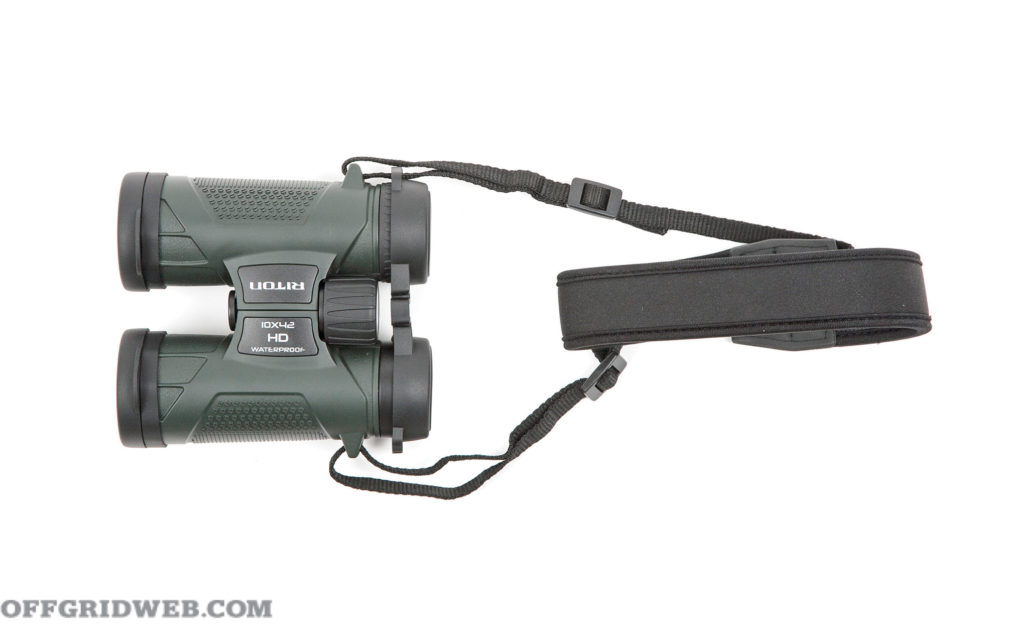
With a magnesium alloy frame, dry nitrogen purged optics, and Riton’s HD glass, the X5 Primal binoculars deliver a wonderfully clear and bright image. The glass is coated with low-light-enhancement, full wide-band, anti-scratch, antireflective, and hydrophobic coatings. The optics are waterproof, fog-proof, and shockproof up to 1,200-G impacts. It’s clear that every dollar was spent on achieving the best image possible at this price point, but that didn’t leave much room for everything else. The housing has textured areas, but its finish is somewhat slippery, rather than soft and rubberized. The neck strap and lens caps are decent, but the carrying case is thin and flimsy with a cheap hook-and-loop closure — basically a throwaway item. It’s possible to overlook these peripheral issues given the great image quality, but you should know what you’re getting when you choose these binoculars.
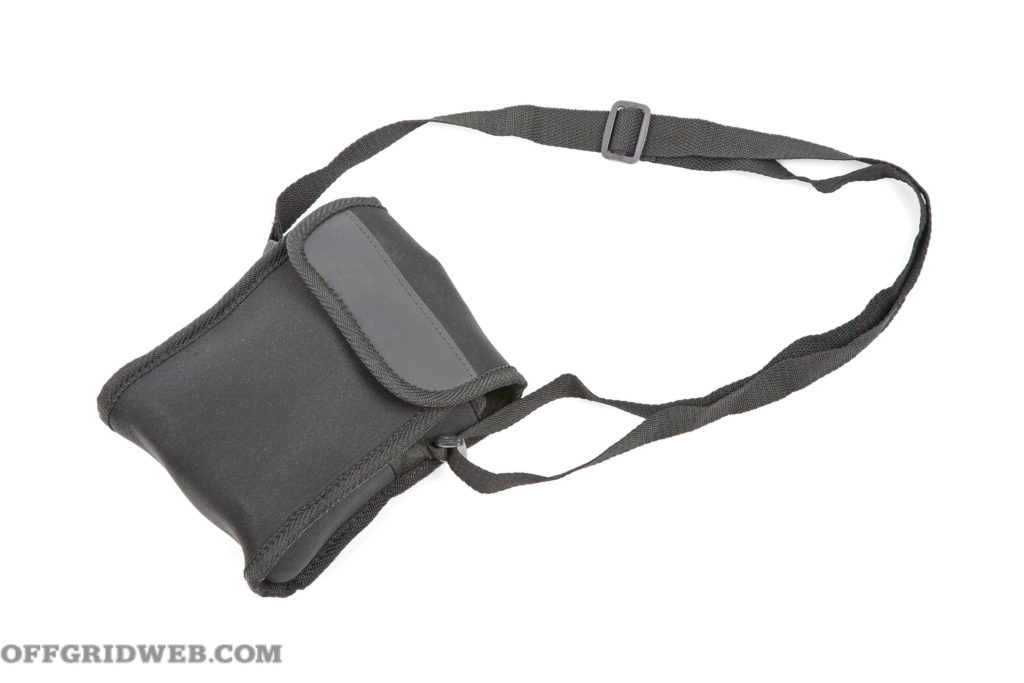
Pros
- The glass itself is very good and provides better image quality than the price would suggest.
- Nitrogen purging is a feature we’d only expect in higher-end binoculars.
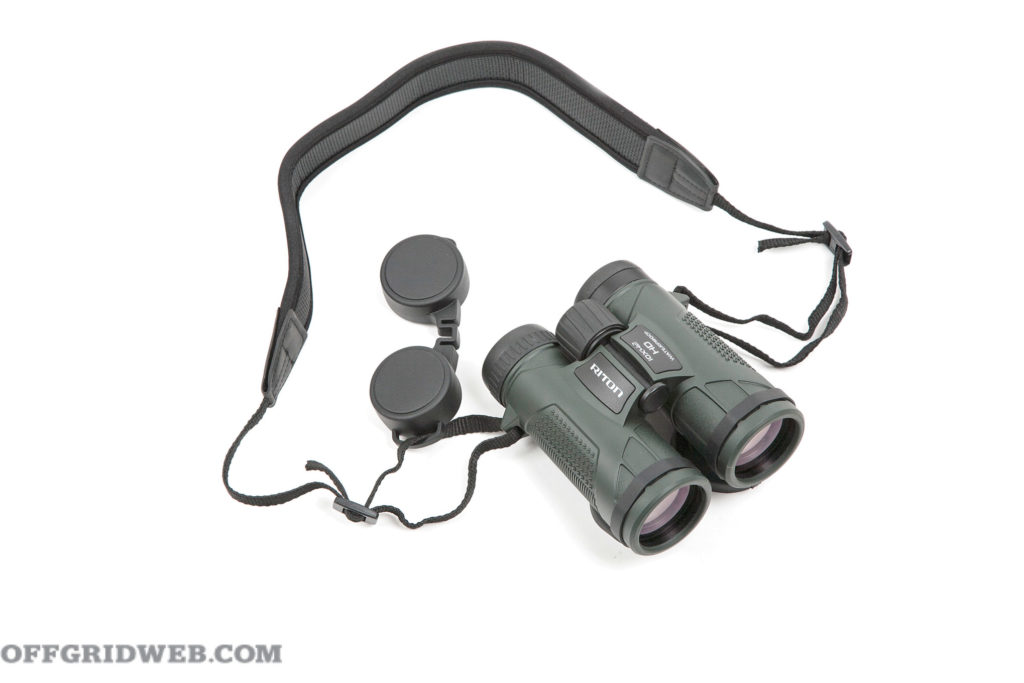
Cons
- Flimsy case feels like it should’ve come with a pair of sub-$100 binocular
- 15mm eye relief isn’t ideal for those who wear glasses.
Steiner T1042r
Dimensions: 6.8 by 4.6 by 2.6 inches
Weight: 1.8 pounds
FOV: 317 feet at 1,000 yards
Eye Relief: 16 millimeters
MSRP: $782
URL: steiner-optics.com
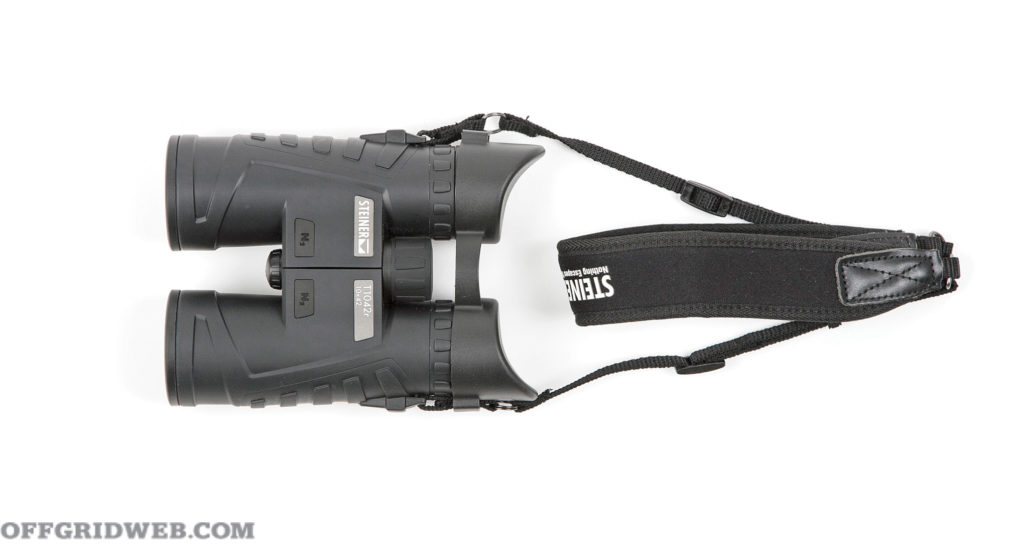
Steiner has brought its riflescope expertise into its Tactical binocular line. The “r” in this model’s name indicates that it has the optional SUMR milliradian targeting reticle integrated into its right tube. If you’re serving as a spotter for a shooter who’s using a 10x rifle scope with mil reticle, this makes it easy to call hits and recommend adjustments. For those who haven’t used binoculars with a reticle before, it’s worth noting that it’ll appear tilted unless your IPD is about halfway through the adjustment range — this is unavoidable, and you may have to tilt your head to accommodate it. Steiner’s fully multi-coated HD glass produces a crisp image from edge to edge, and the optics are filled with 14-psi-pressurized dry nitrogen to repel moisture in extreme conditions. The rubberized housing is comfortable, and we appreciate the ClicLoc quick-detach clips for the neck strap and front covers.

Pros
- Clear image and very good low-light performance
- Comfortable, rubberized eyecups and peripheral shields make these a great choice for LEOs and hunters who spend many hours behind binoculars
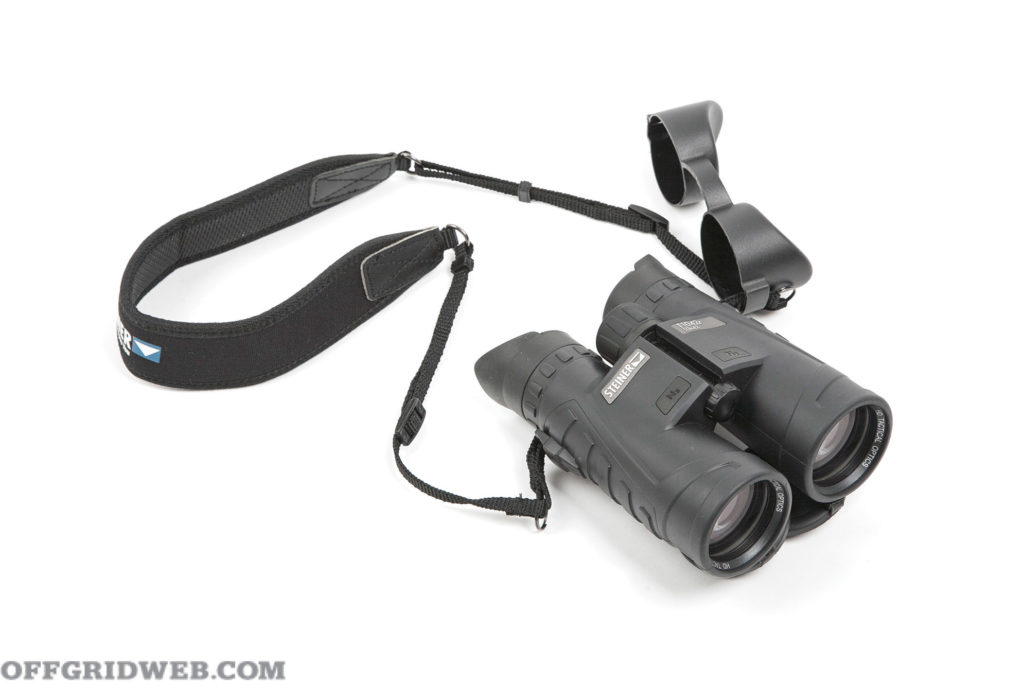
Cons
- Unless you frequently need the reticle for spotting, it may be distracting, and it comes at a substantial price increase from the standard T1042 ($545).
- Those who aren’t blessed with IPD close to 64mm will always see a tilted reticle
Vortex Diamondback HD 10×42
Dimensions: 6.8 by 4.6 by 2.6 inches
Weight: 1.8 pounds
FOV: 330 feet at 1,000 yards
Eye Relief: 15 millimeters
MSRP: $280
URL: vortexoptics.com
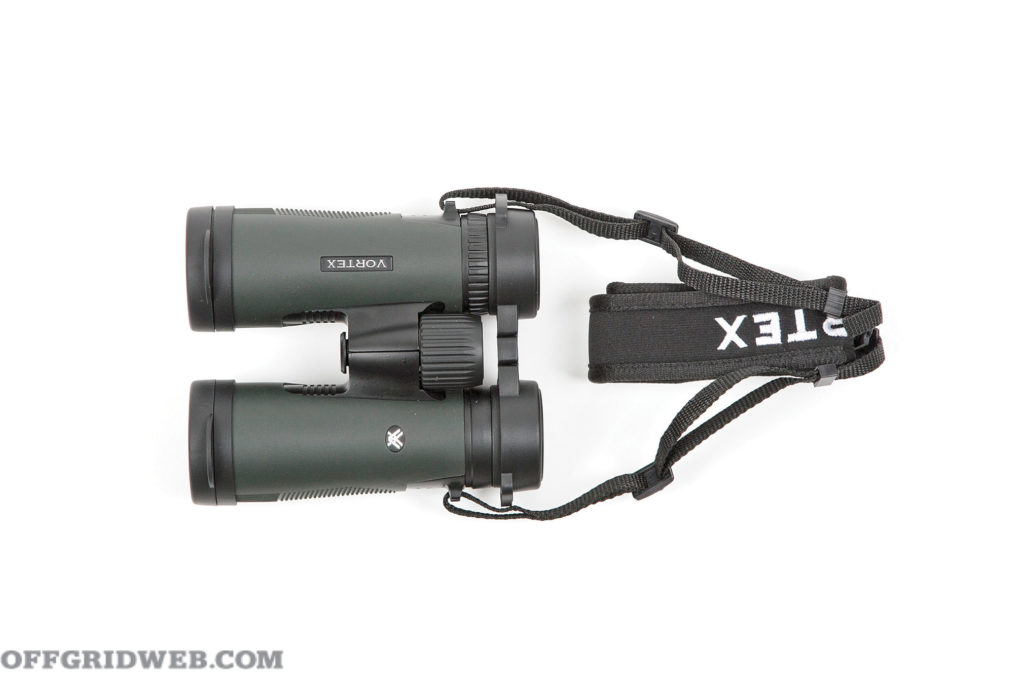
Vortex says the Diamondback HD “optically punches high above its class.” Clarity and color fidelity are good for the money — mostly comparable to the $70 more expensive Bushnell — but they didn’t dramatically exceed expectations. Then again, we noticed that these binos retail for around $230, at which point they offer a lot of bang for the buck. Focus and diopter adjustment are smooth, although the former dial makes a faint but disconcerting crunching noise as it turns. The dark green rubberized housing isn’t especially grippy, but does have textured areas for each palm. Our favorite feature is the GlassPak carrying case, which comes with an X-harness to secure it on your chest. This eliminates the annoyance of binoculars bouncing off your sternum as you walk. The case also includes two side pockets for small items like sunglasses, and a zippered rear pocket for a map or cleaning cloth.
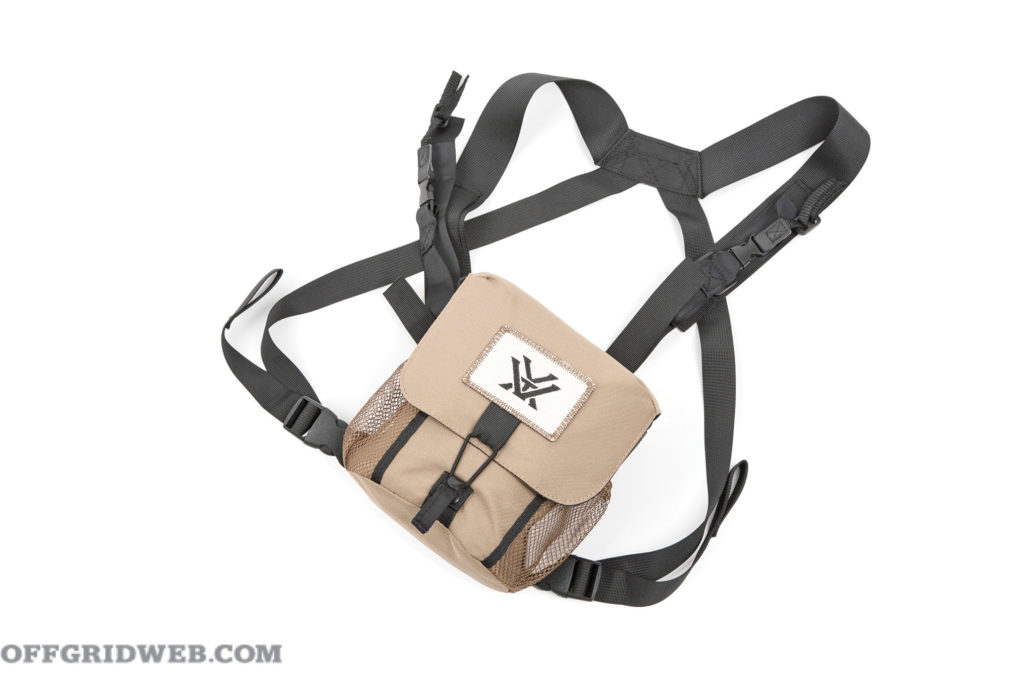
Pros
- The GlassPak carrying case is great, with a helpful chest harness and room for accessories.
- Can be found for about $50 below MSRP at various retailers, making it a good value
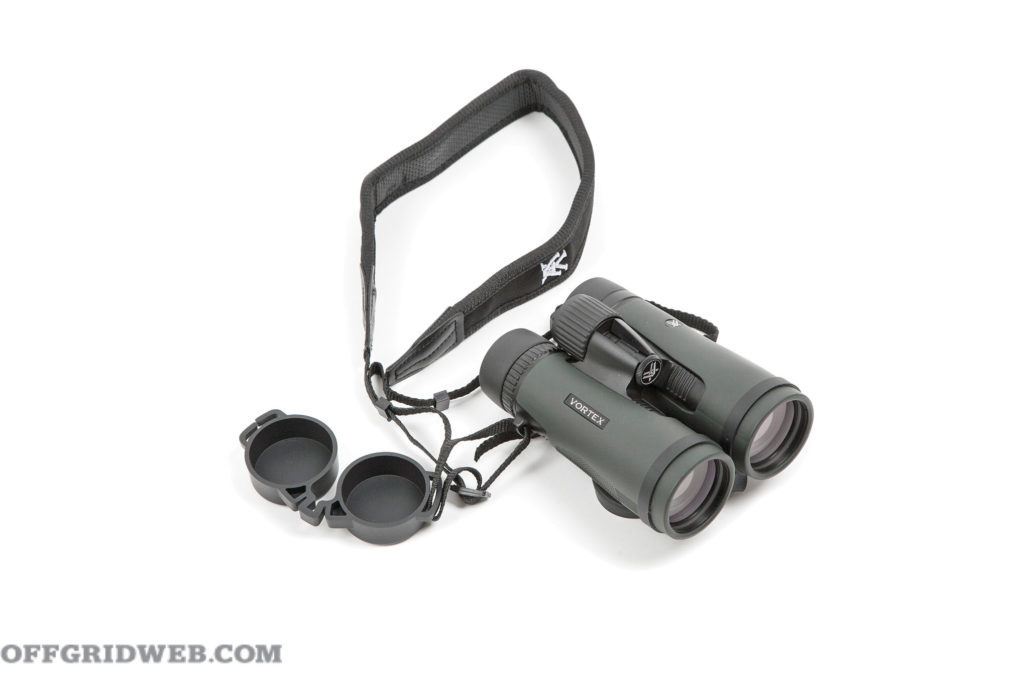
Cons
- Imperfect clarity and noticeable chromatic aberration at the edges
- Housing could use more texture to maintain grip in wet conditions
- 15mm eye relief isn’t ideal for those who wear glasses.
More on OFFGRID
- Portable Utensils Buyer’s Guide: Have Spork, Will Travel
- Night Vision Helmet Setup Guide
- Night Vision Goggles: A Double Primer
- GBRS Group: Shadows that Bite
- Vaporwear: Gas Mask Buyer’s Guide.

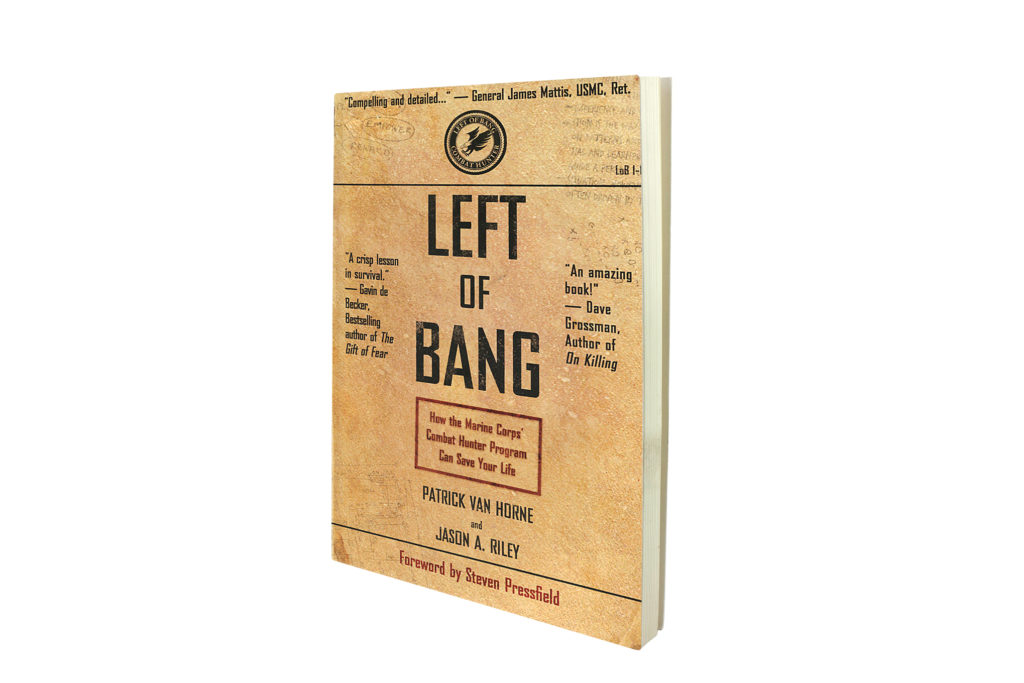
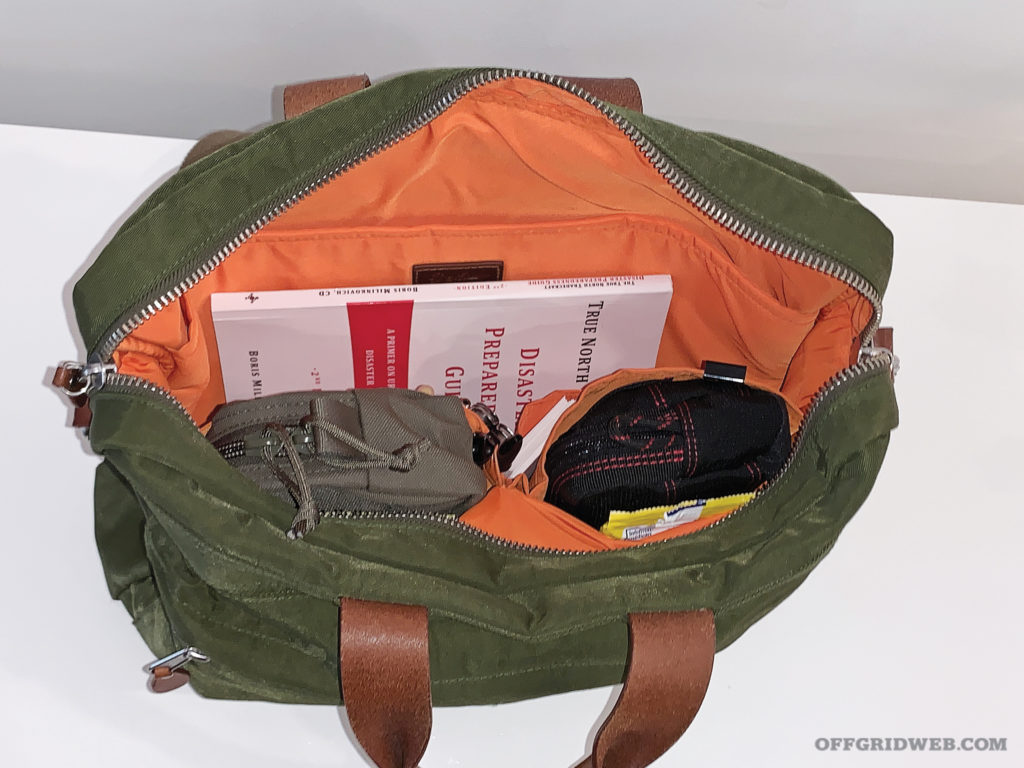
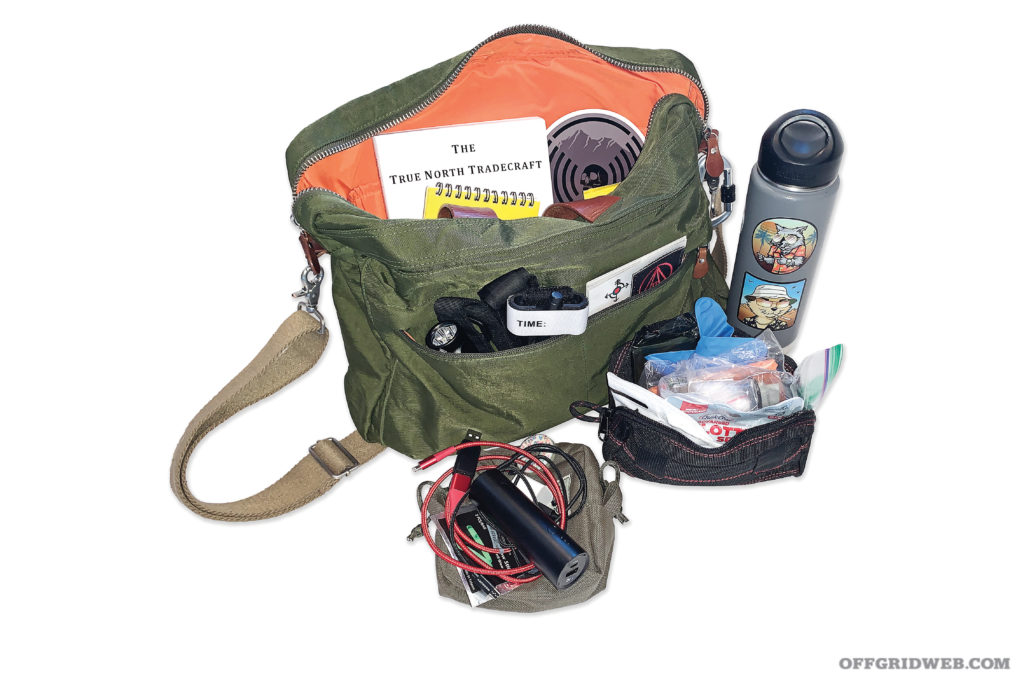
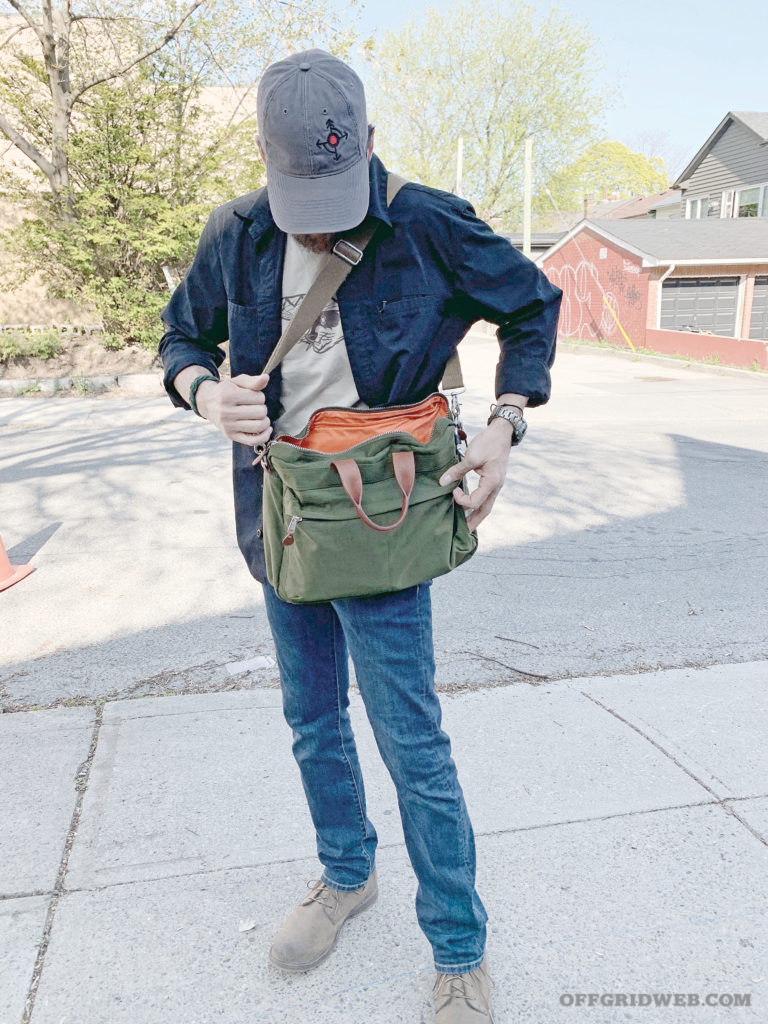
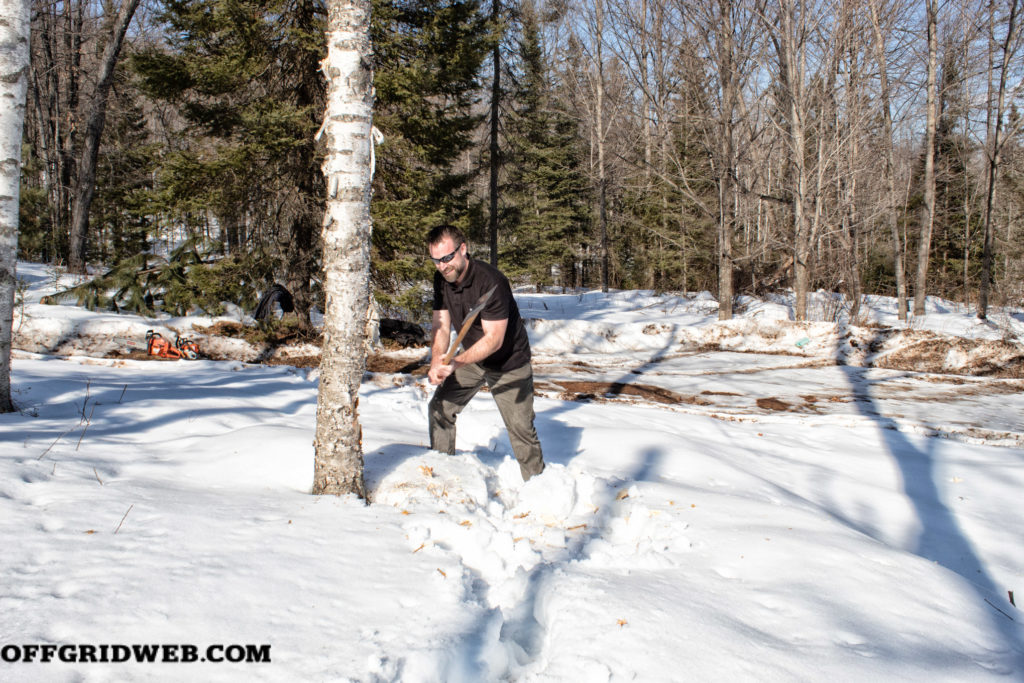

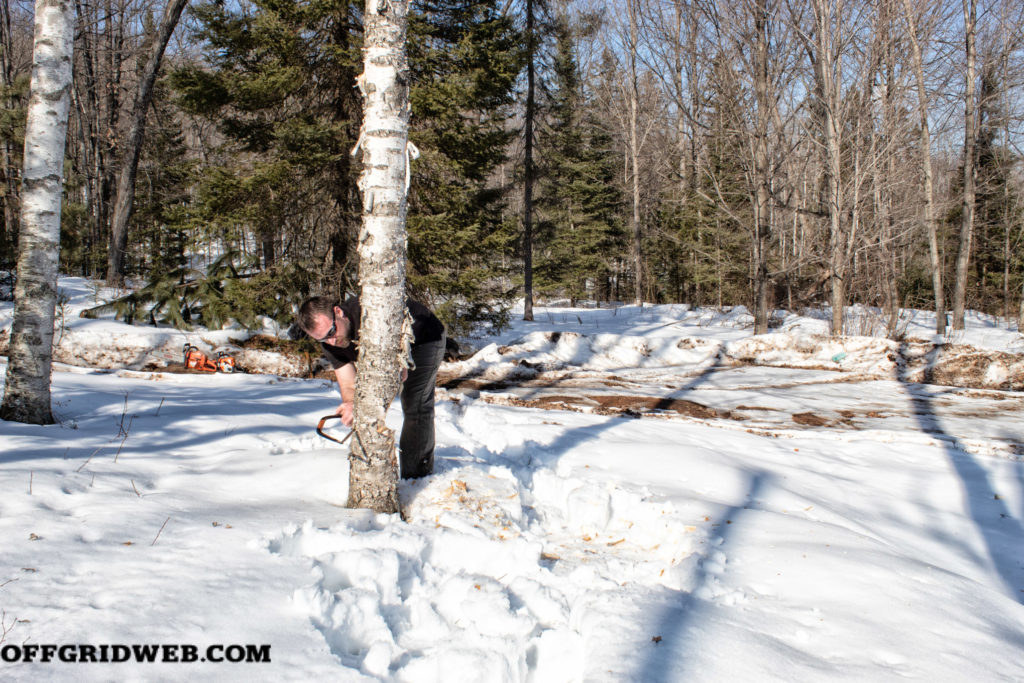
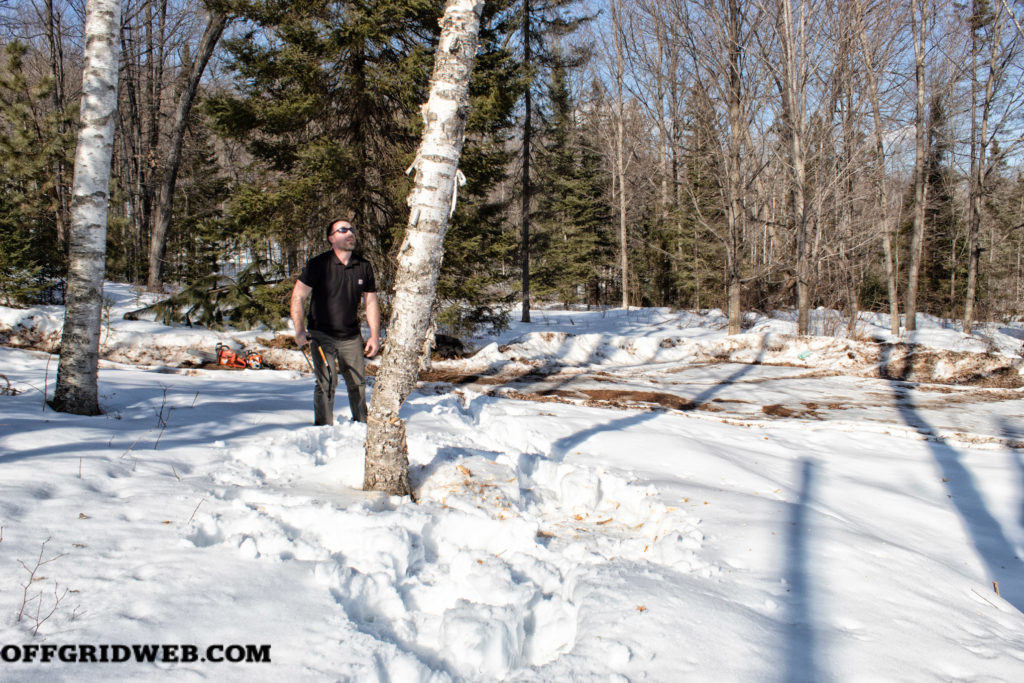
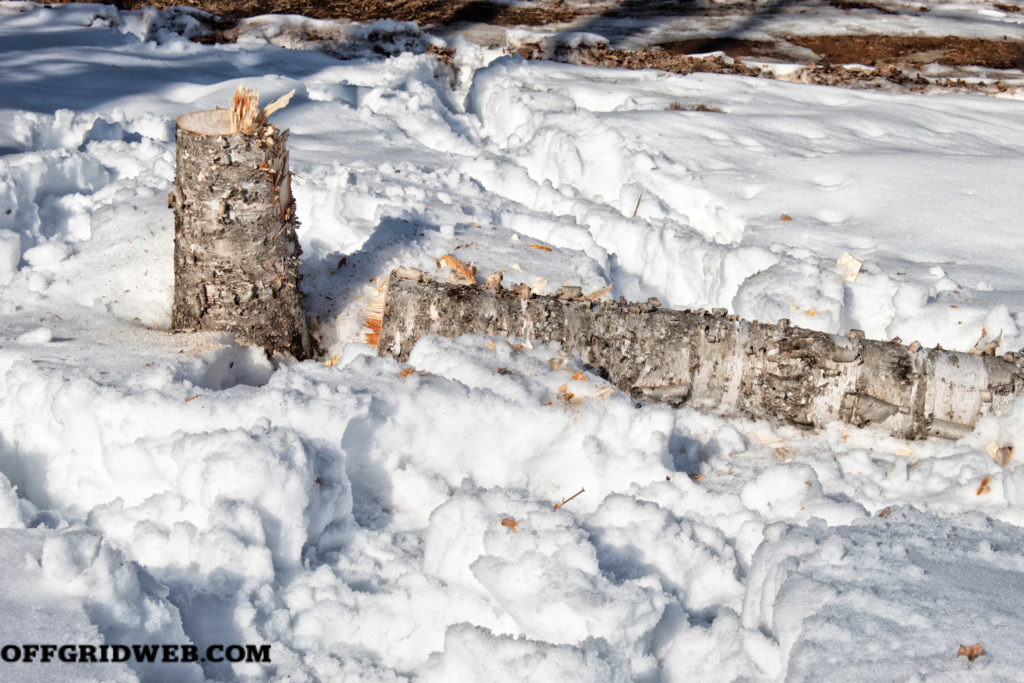
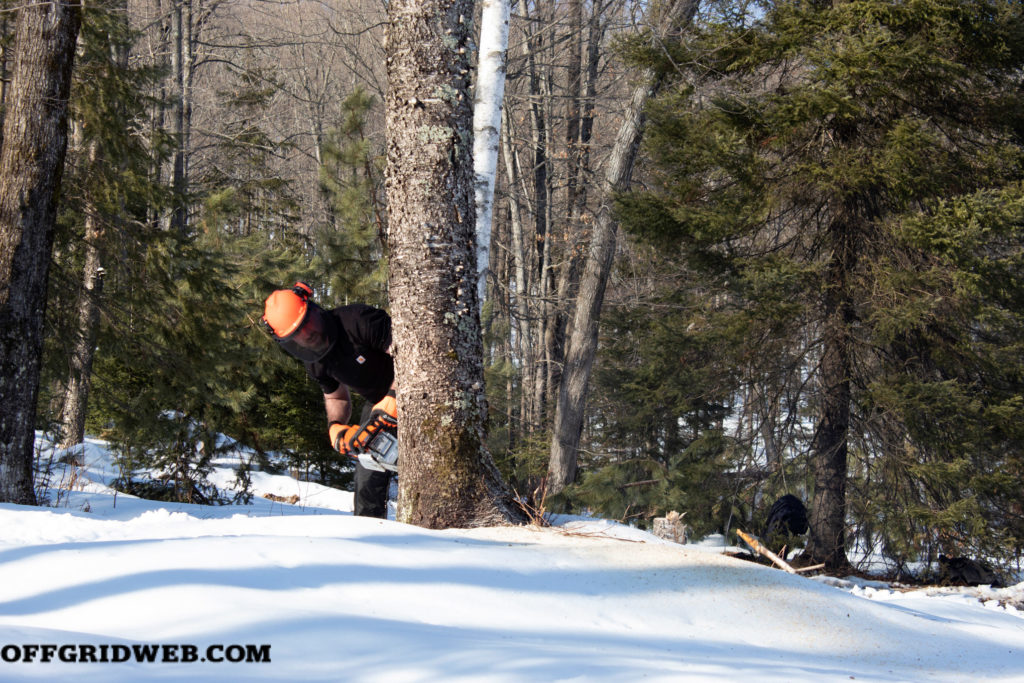
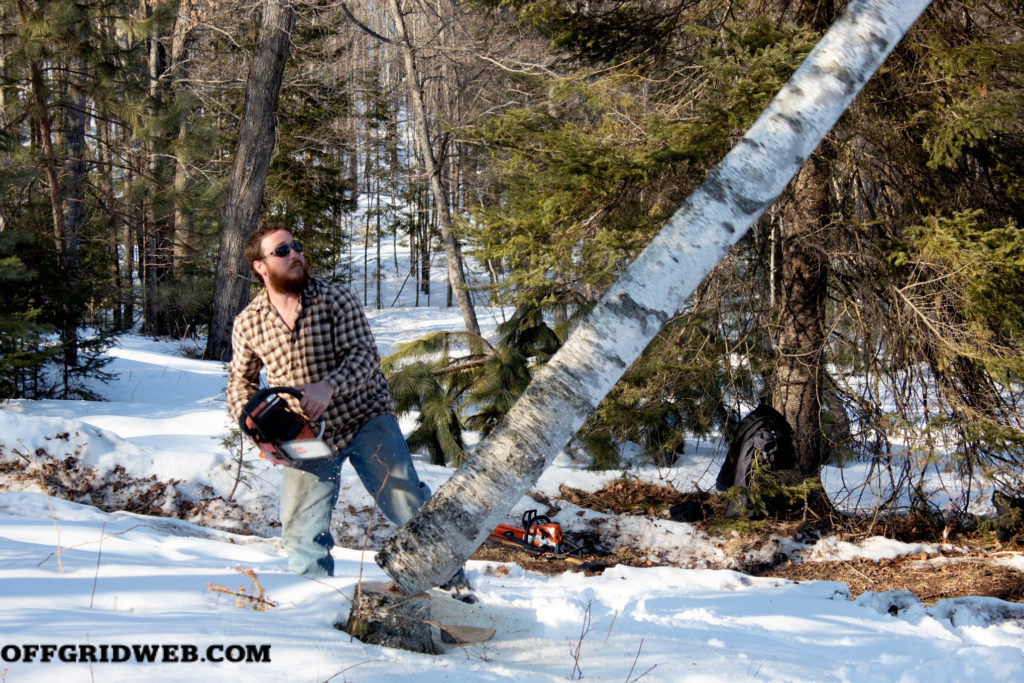
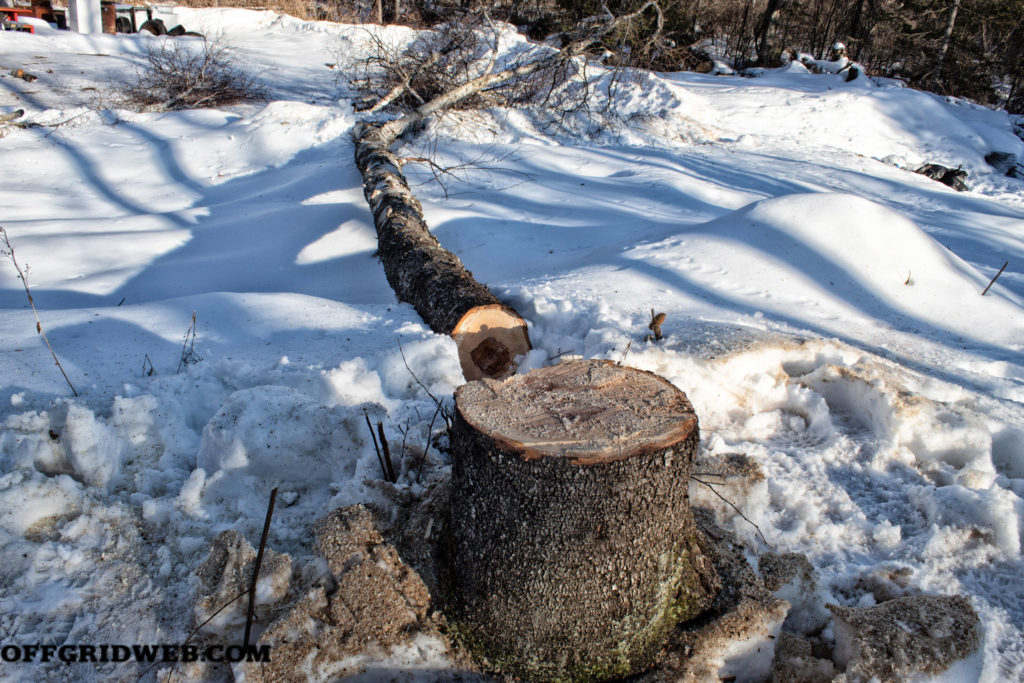


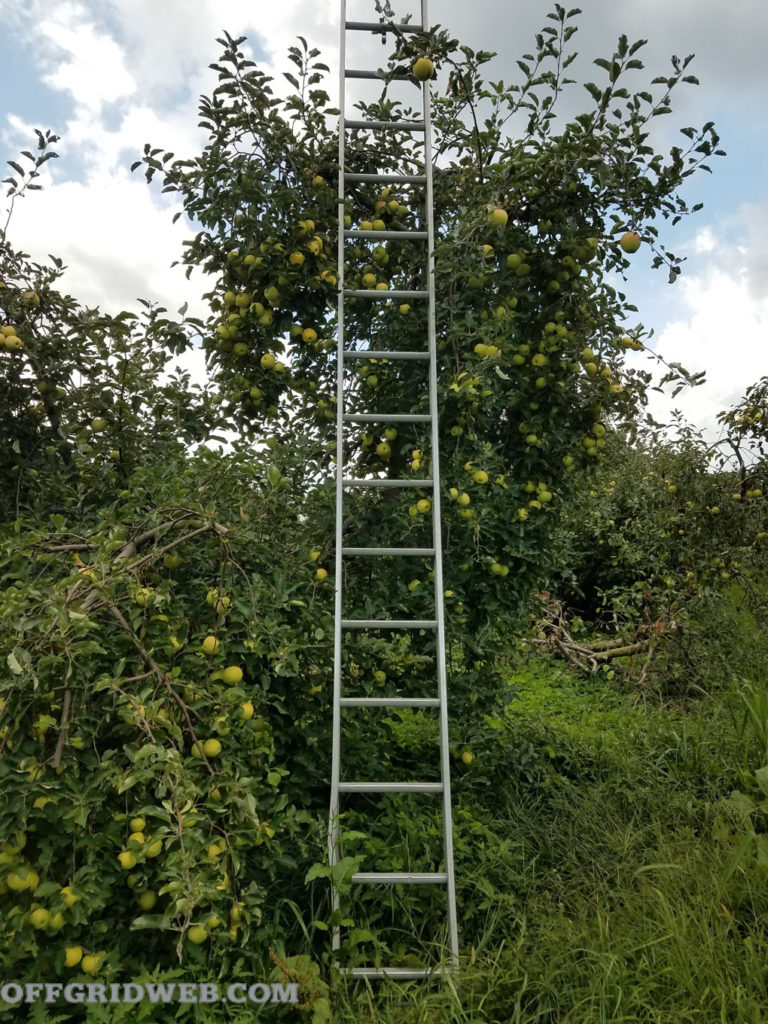



 Above: The more humid your climate, the earlier you’ll need to manage for fungal diseases in grapes.
Above: The more humid your climate, the earlier you’ll need to manage for fungal diseases in grapes.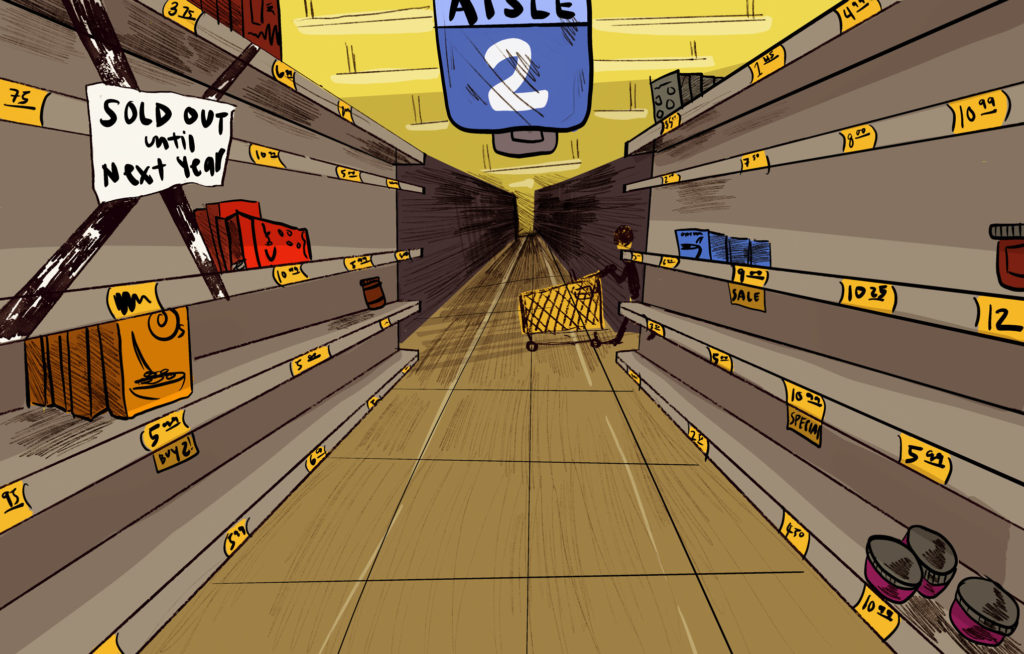
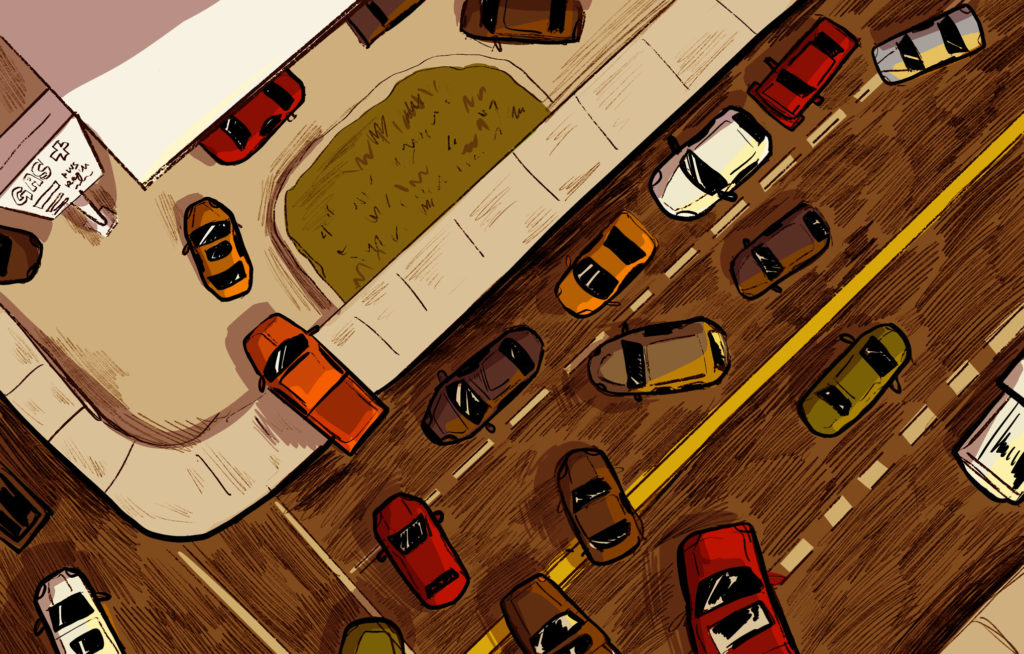
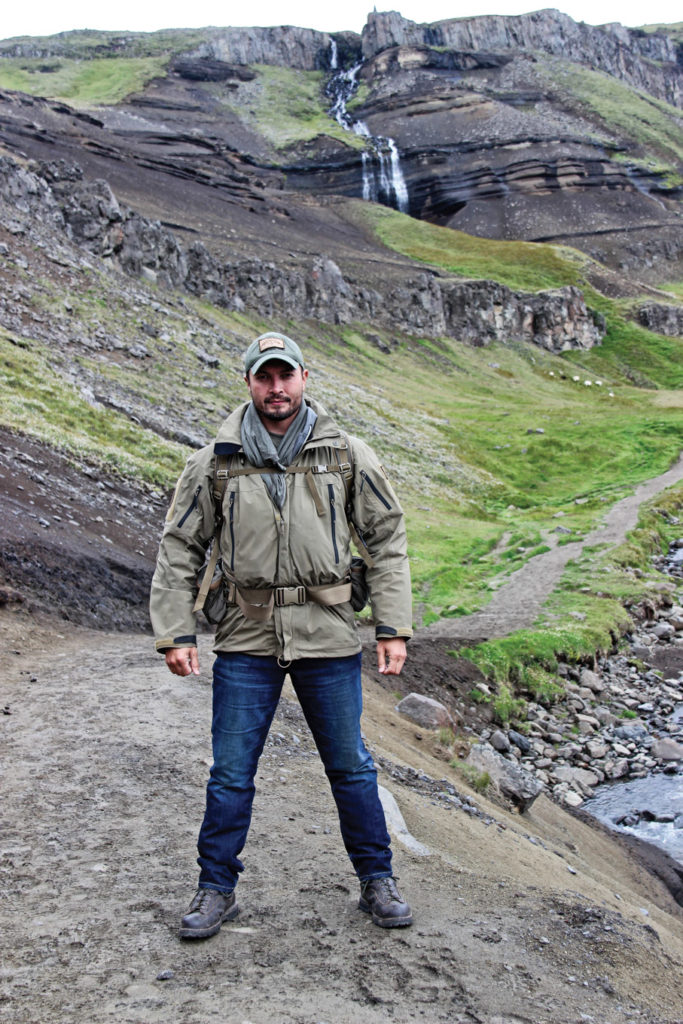

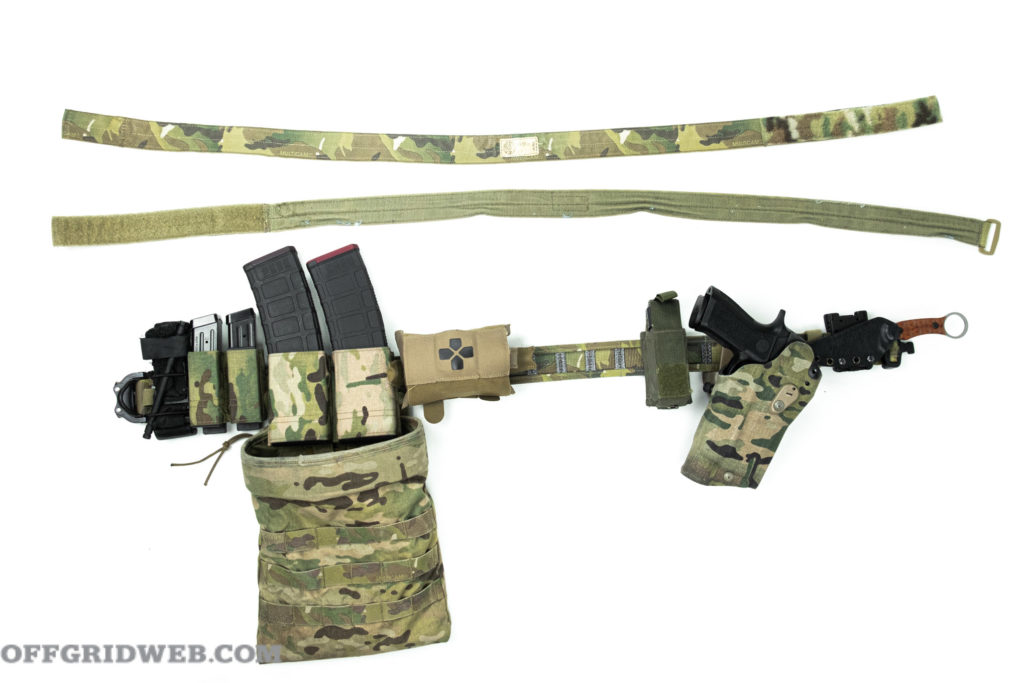

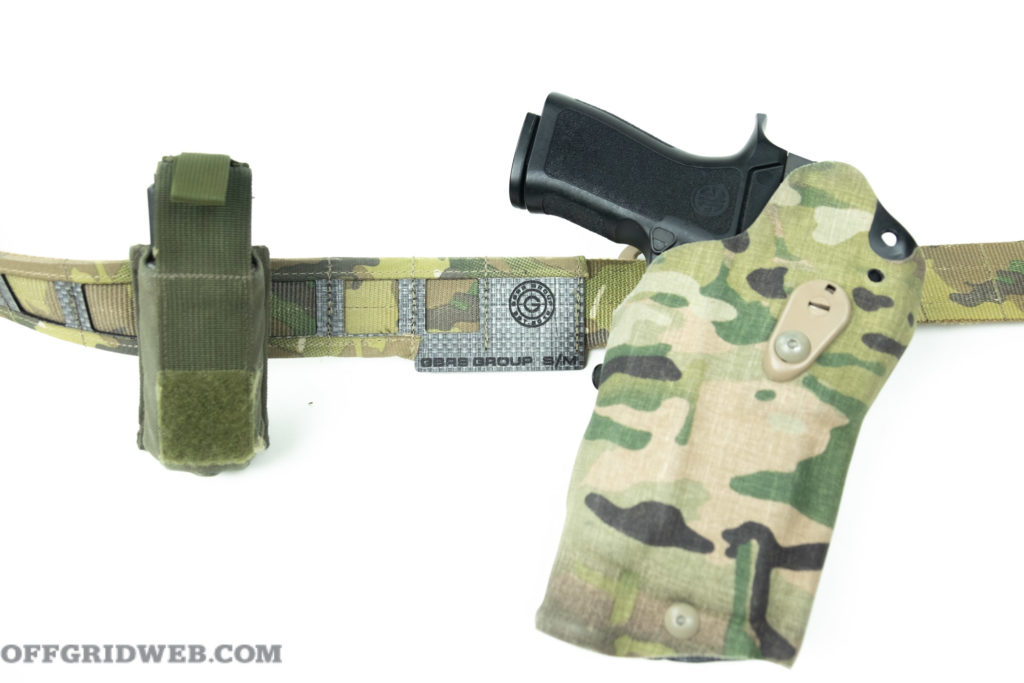

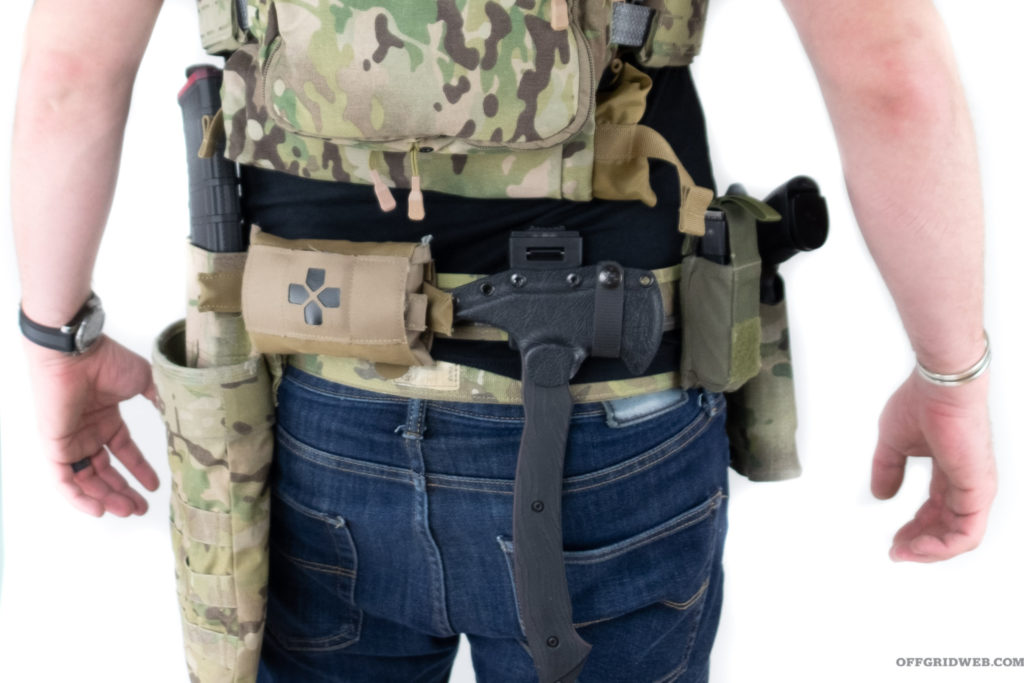
 Does the GBRS Group Assaulter Belt base layer make for a good EDC belt? Yes and no. Until a Black version is released, it comes in Multicam, which in some places it is viewed as a mere random fashion choice, in others, like Minneapolis, it’ll draw attention at the time of writing. Make no mistake, you’re not taking off your pants in a steamy, sexy slow-motion smooth maneuver, instead, it’s the tearing sound of hook and loop fastening. In regards to EDC gear, this is chastity belt secure, however. What’s attached is staying attached.
Does the GBRS Group Assaulter Belt base layer make for a good EDC belt? Yes and no. Until a Black version is released, it comes in Multicam, which in some places it is viewed as a mere random fashion choice, in others, like Minneapolis, it’ll draw attention at the time of writing. Make no mistake, you’re not taking off your pants in a steamy, sexy slow-motion smooth maneuver, instead, it’s the tearing sound of hook and loop fastening. In regards to EDC gear, this is chastity belt secure, however. What’s attached is staying attached.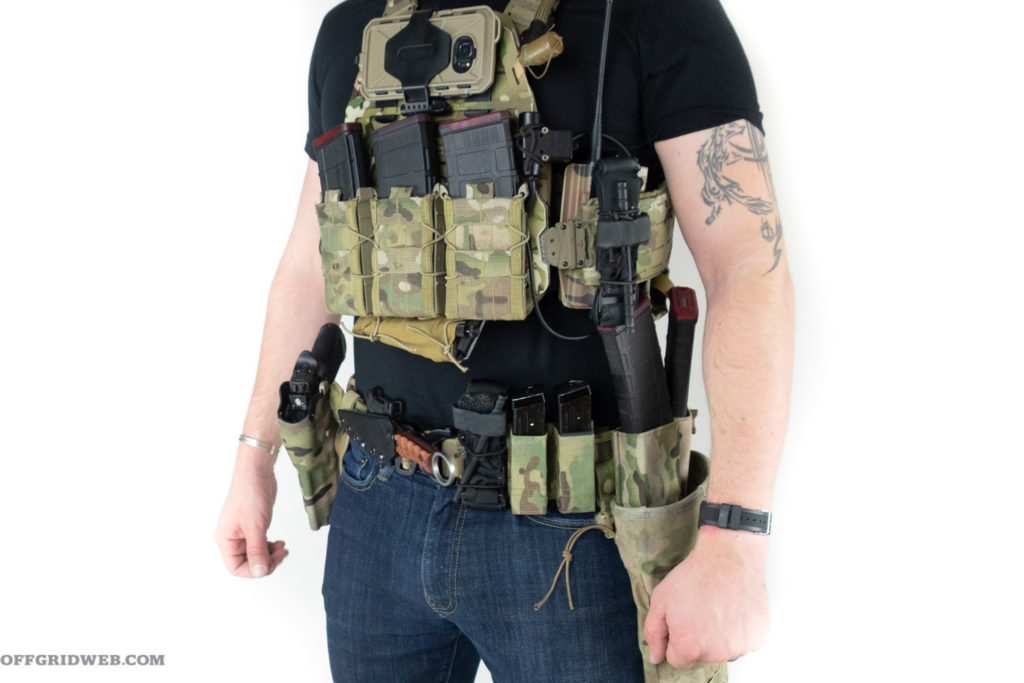
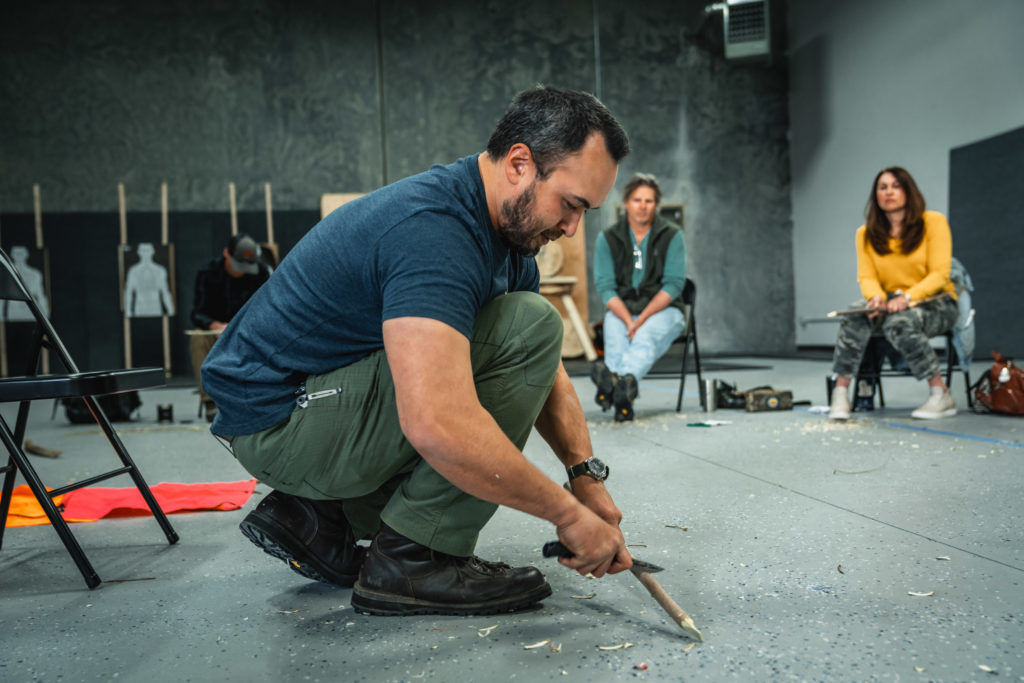
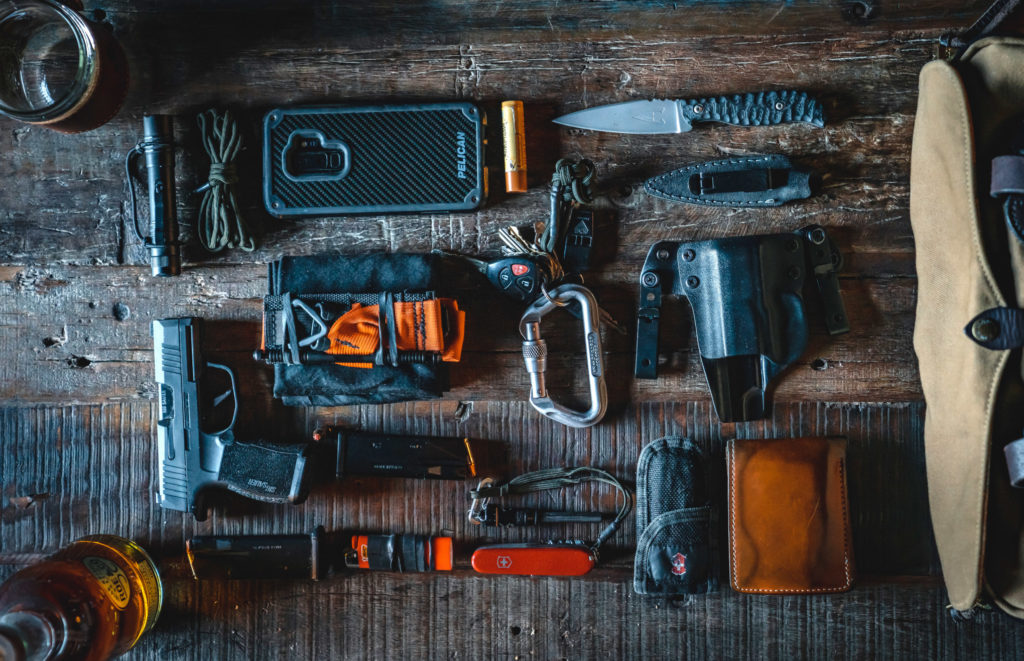

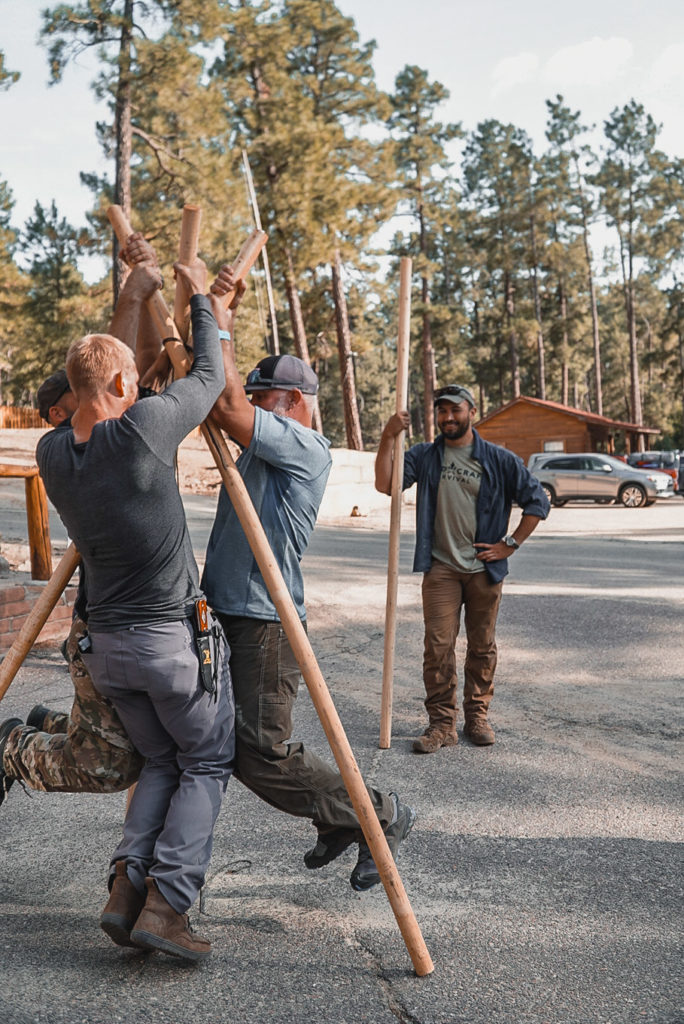
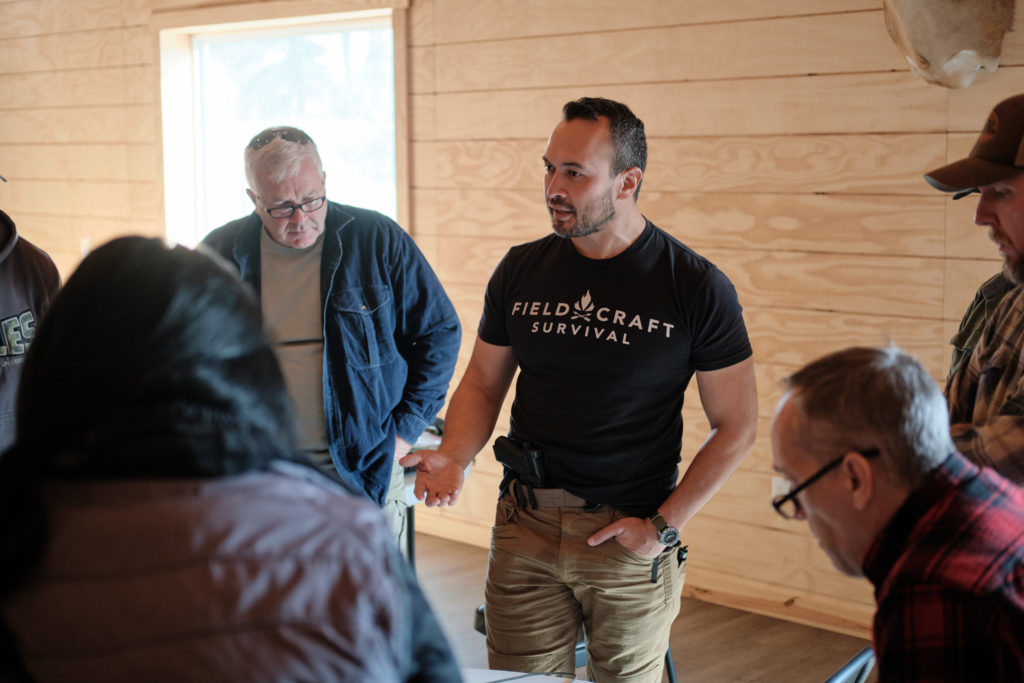
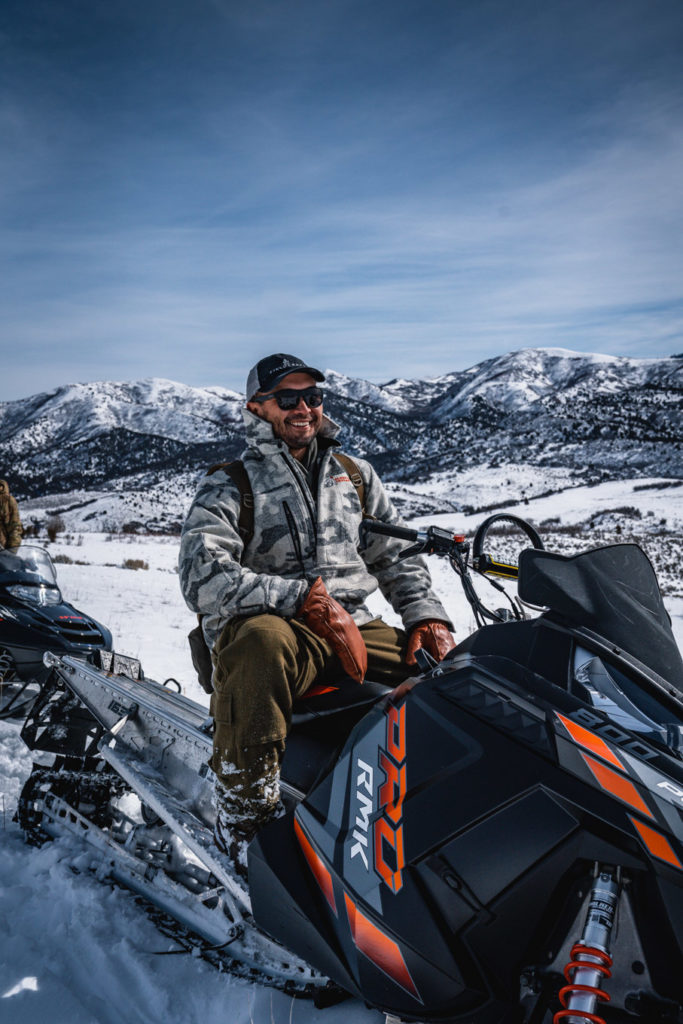
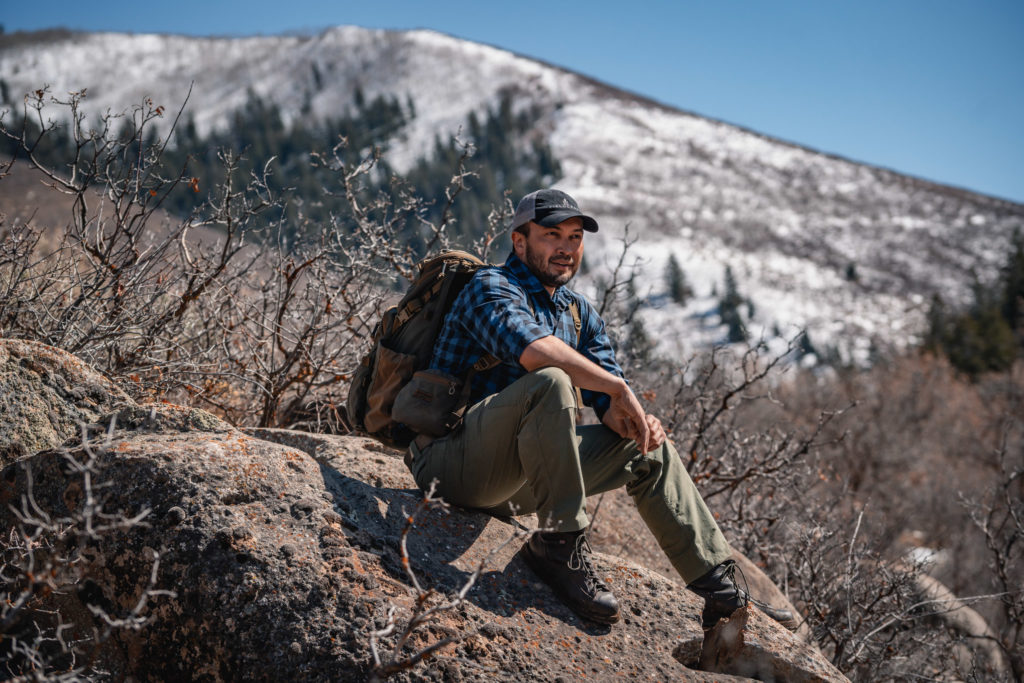
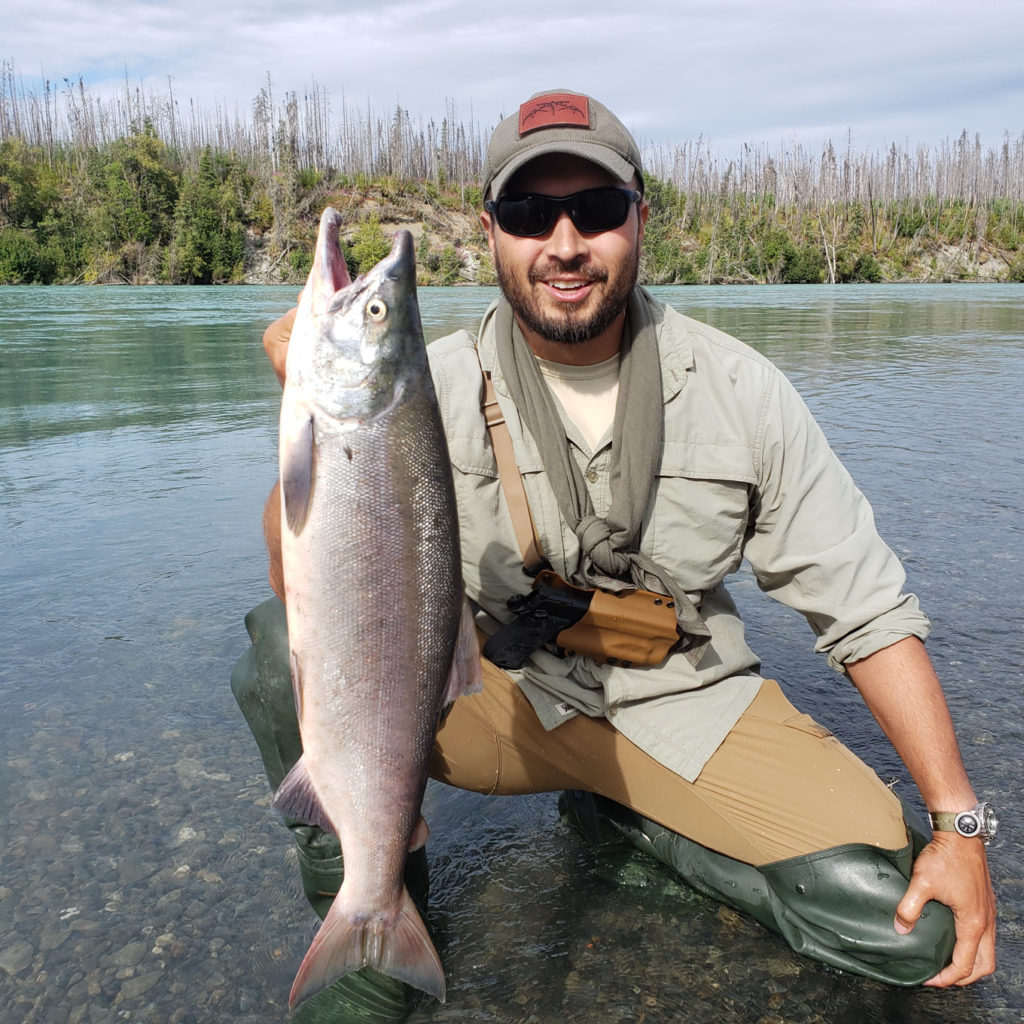
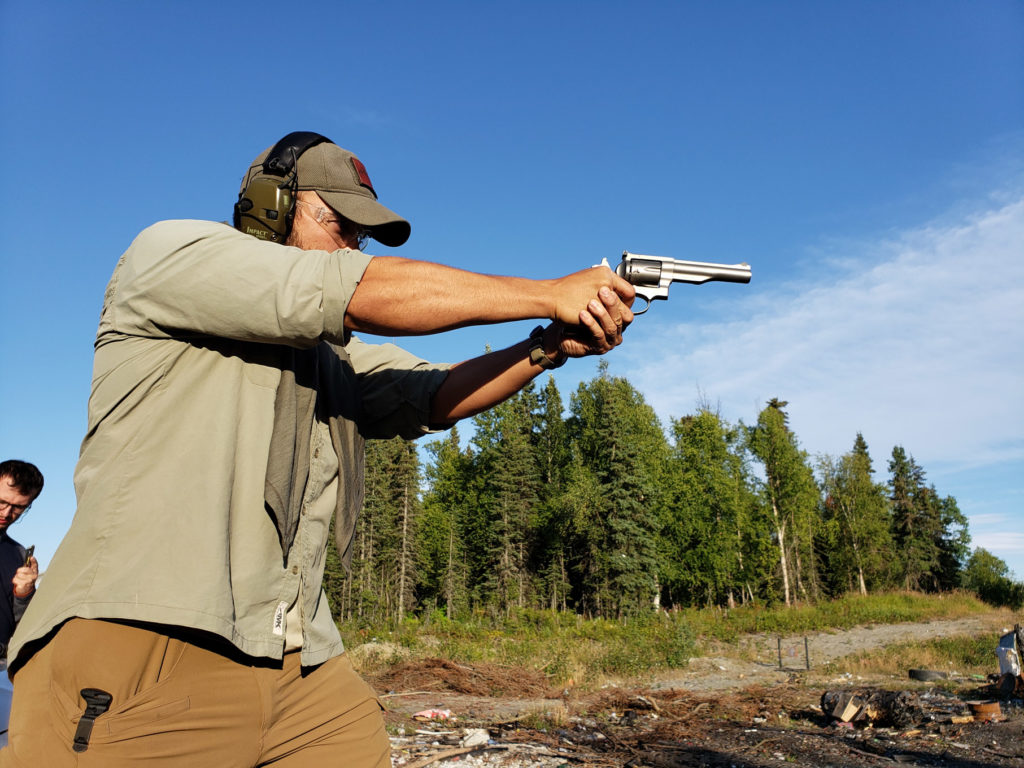
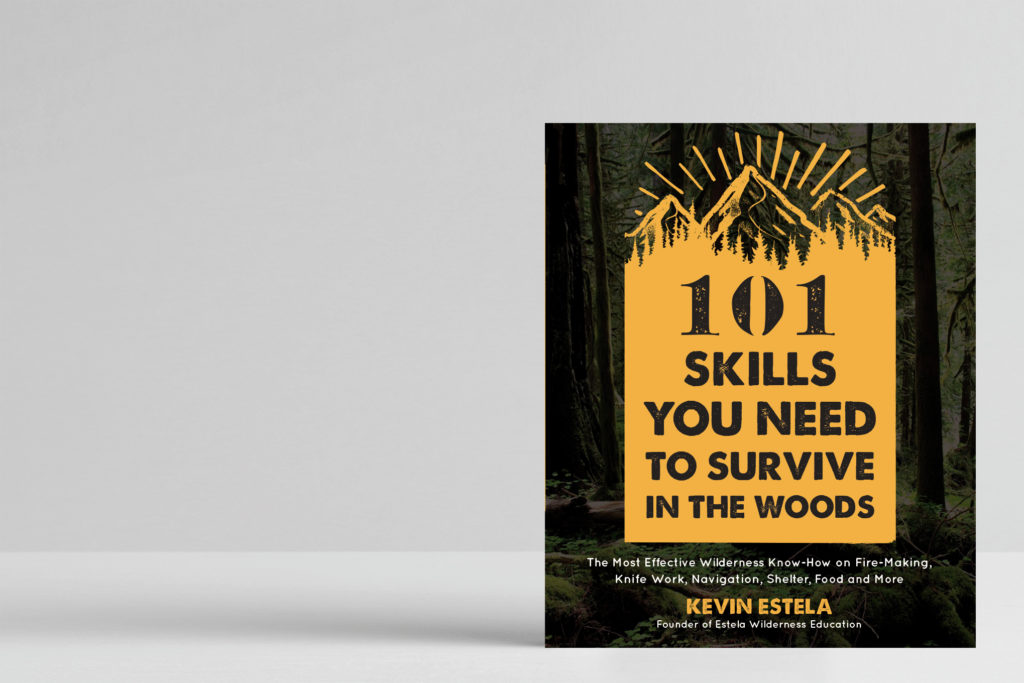
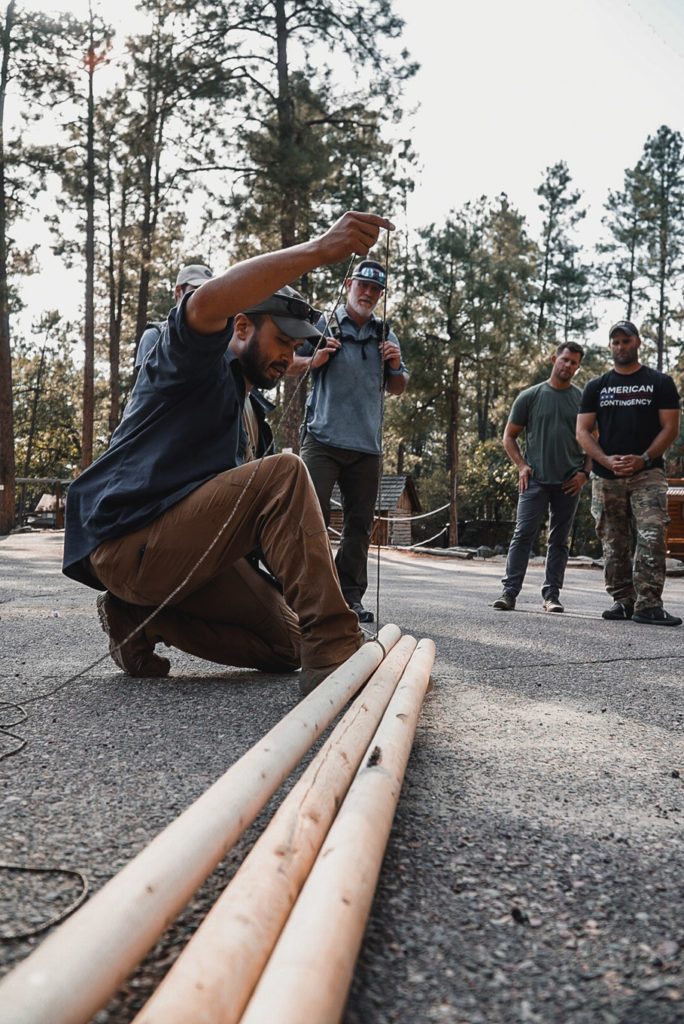
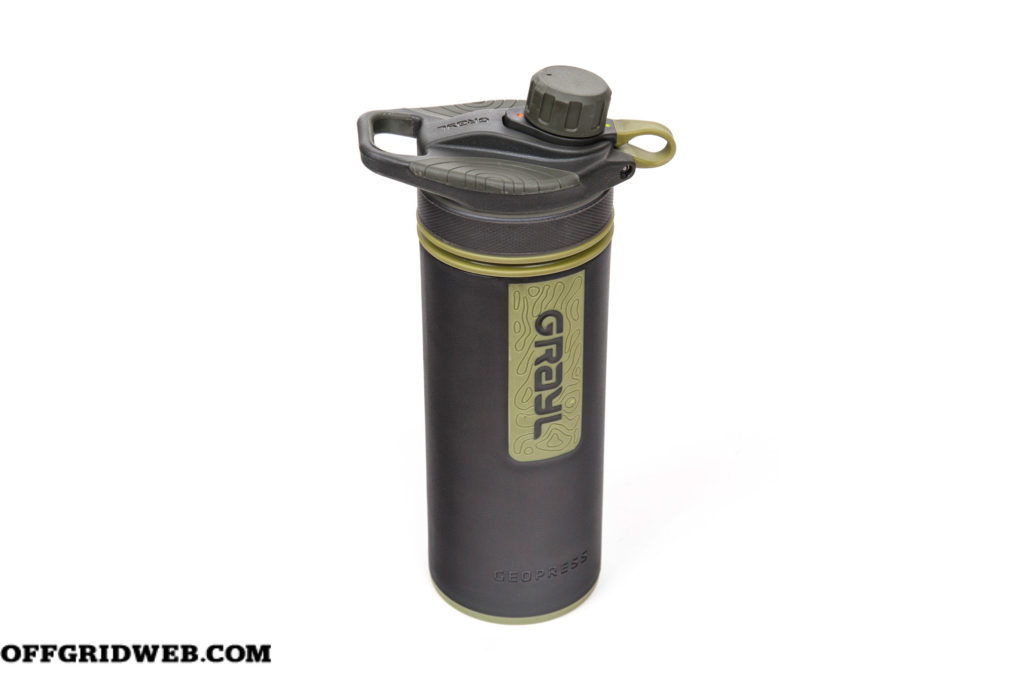
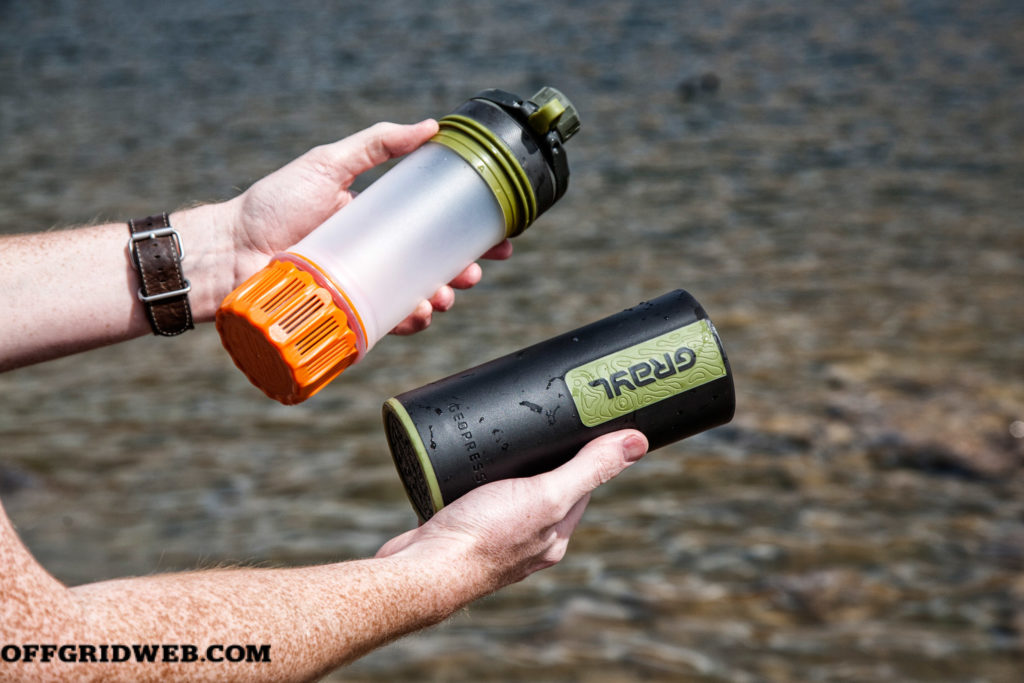 1. Pull apart to separate outer sleeve from the purifier.
1. Pull apart to separate outer sleeve from the purifier.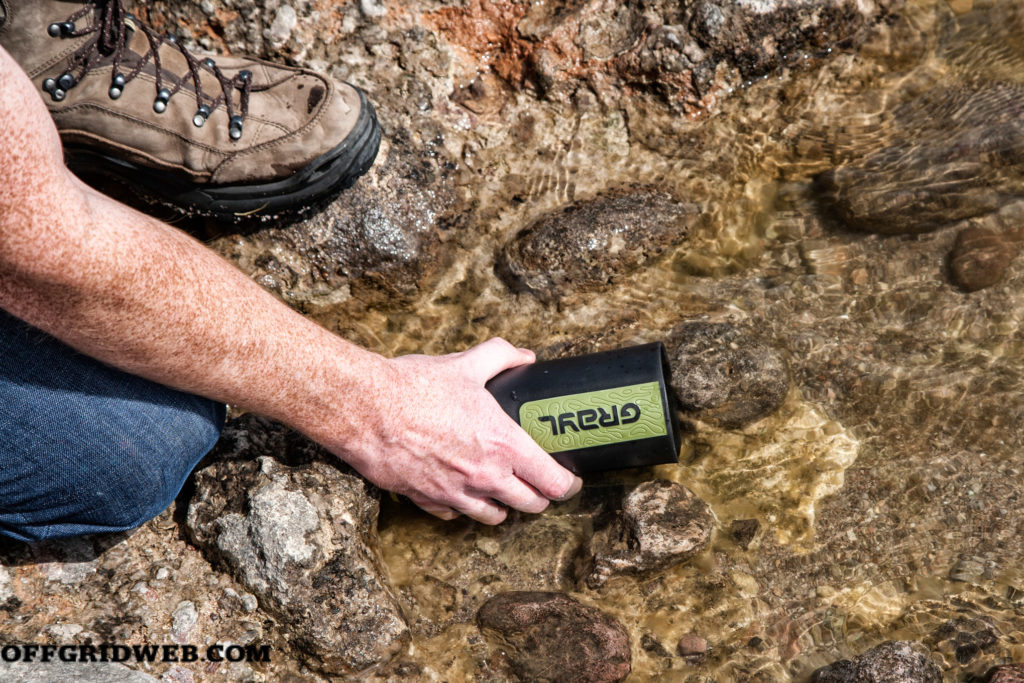 2. Fill sleeve with dirty water to the indicated maximum line.
2. Fill sleeve with dirty water to the indicated maximum line.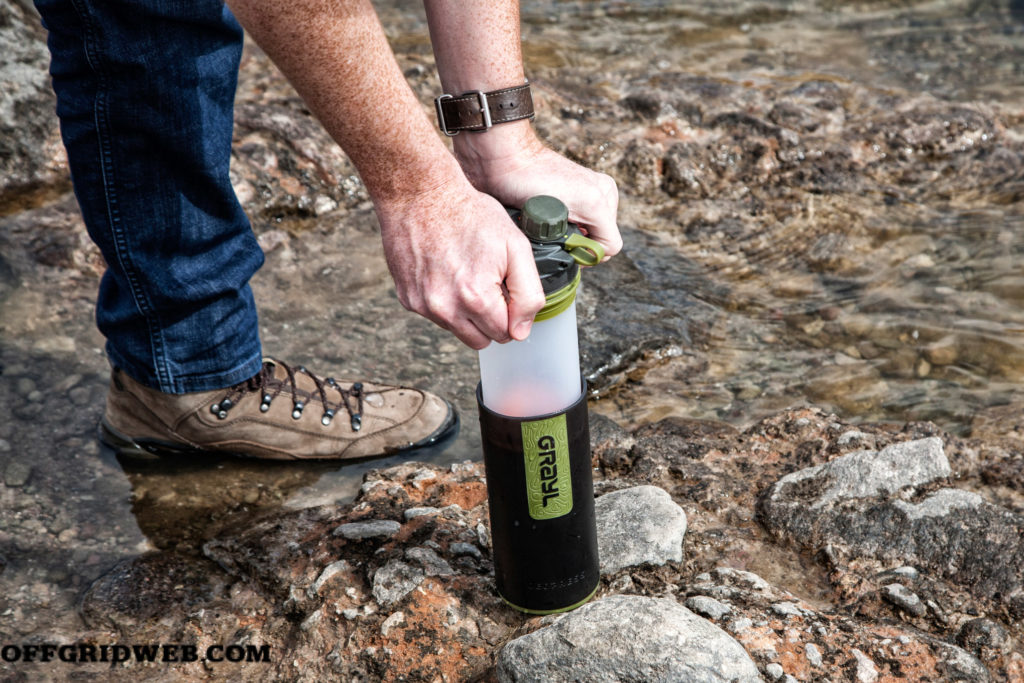 3. Loosen “Simplevent” spout cap by a half turn to allow air to escape. Then, press the purifier firmly into the sleeve, forcing water up through the purifier cartridge.
3. Loosen “Simplevent” spout cap by a half turn to allow air to escape. Then, press the purifier firmly into the sleeve, forcing water up through the purifier cartridge.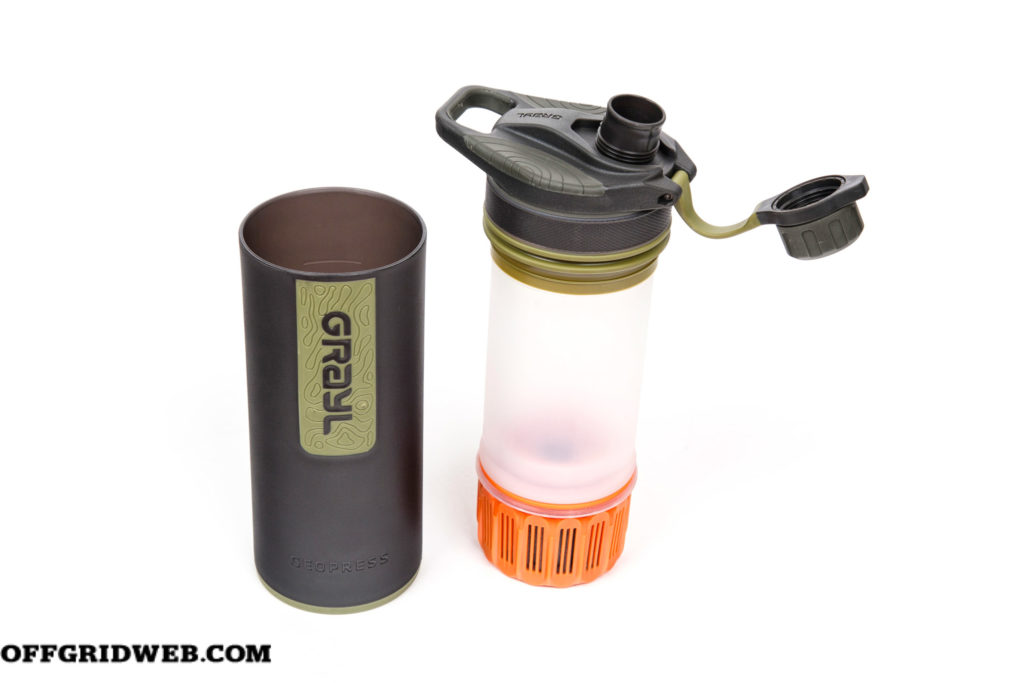
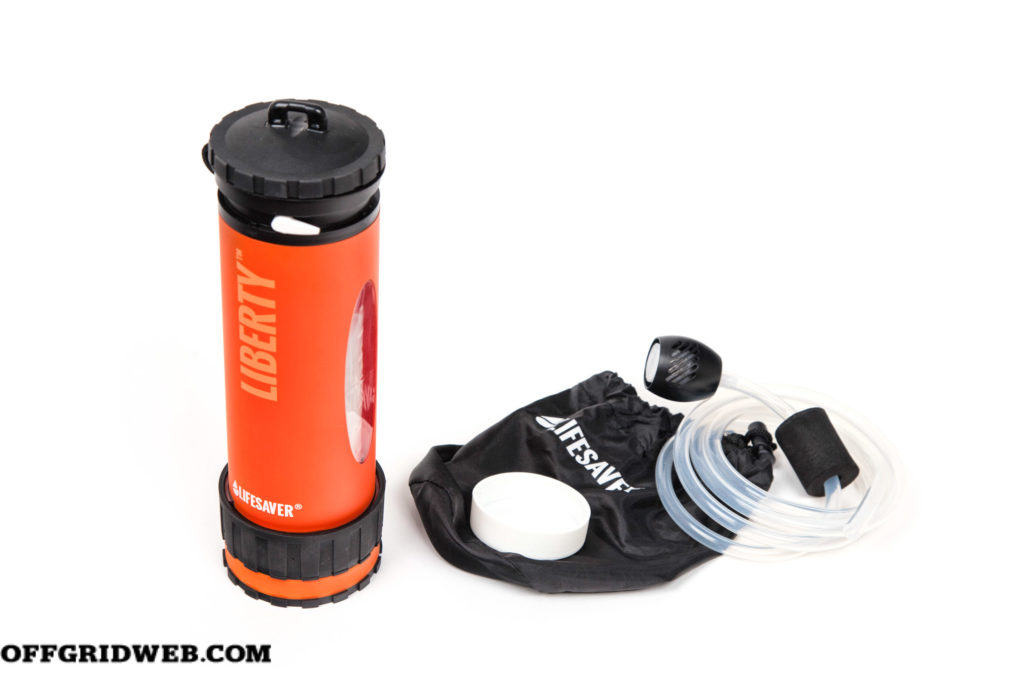
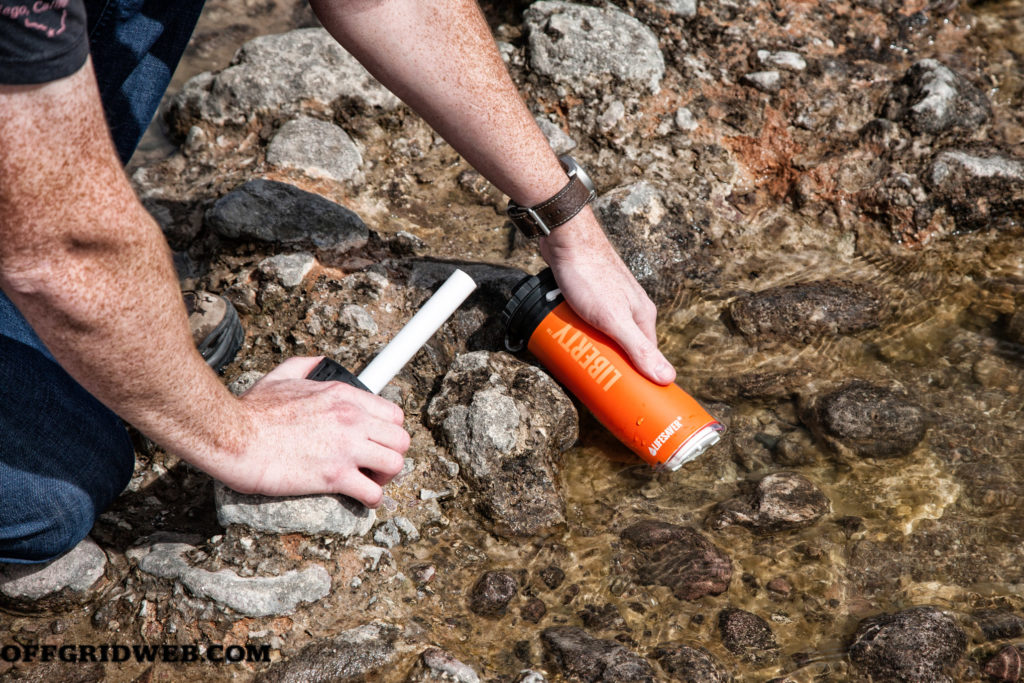 1. Unscrew base of purifier, and scoop dirty water into the reservoir.
1. Unscrew base of purifier, and scoop dirty water into the reservoir. 2. Tightly screw on base, then twist bottom cap a half turn to unlock pump handle. Pump three times.
2. Tightly screw on base, then twist bottom cap a half turn to unlock pump handle. Pump three times.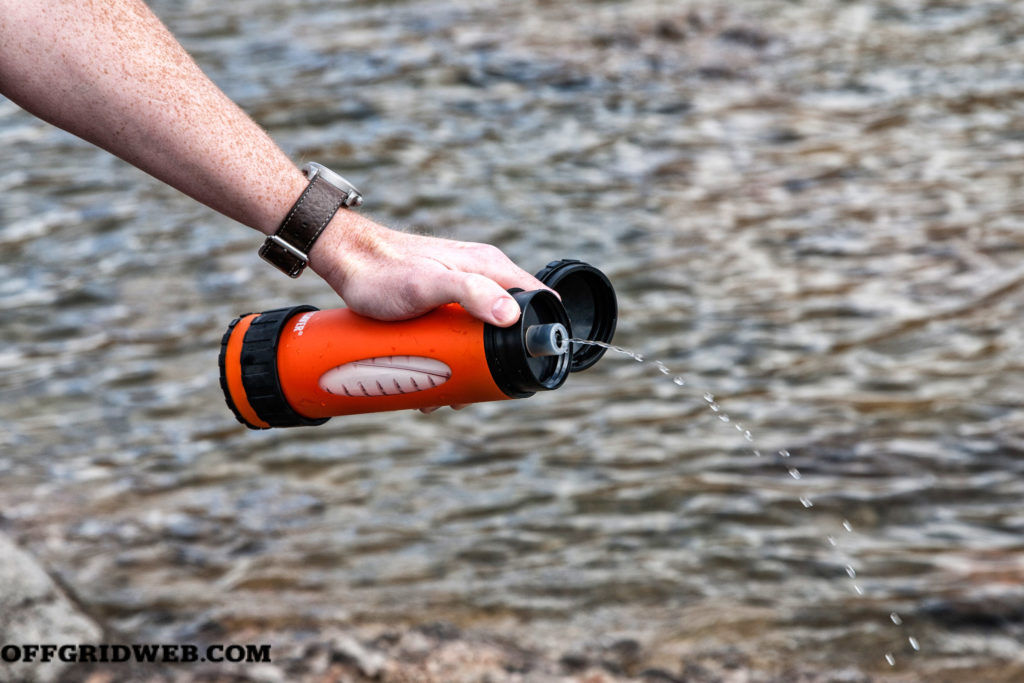 3. Unscrew top cap and rotate white flow valve 90 degrees to release pressurized water from nozzle. Continue pumping to maintain flow rate as needed.
3. Unscrew top cap and rotate white flow valve 90 degrees to release pressurized water from nozzle. Continue pumping to maintain flow rate as needed.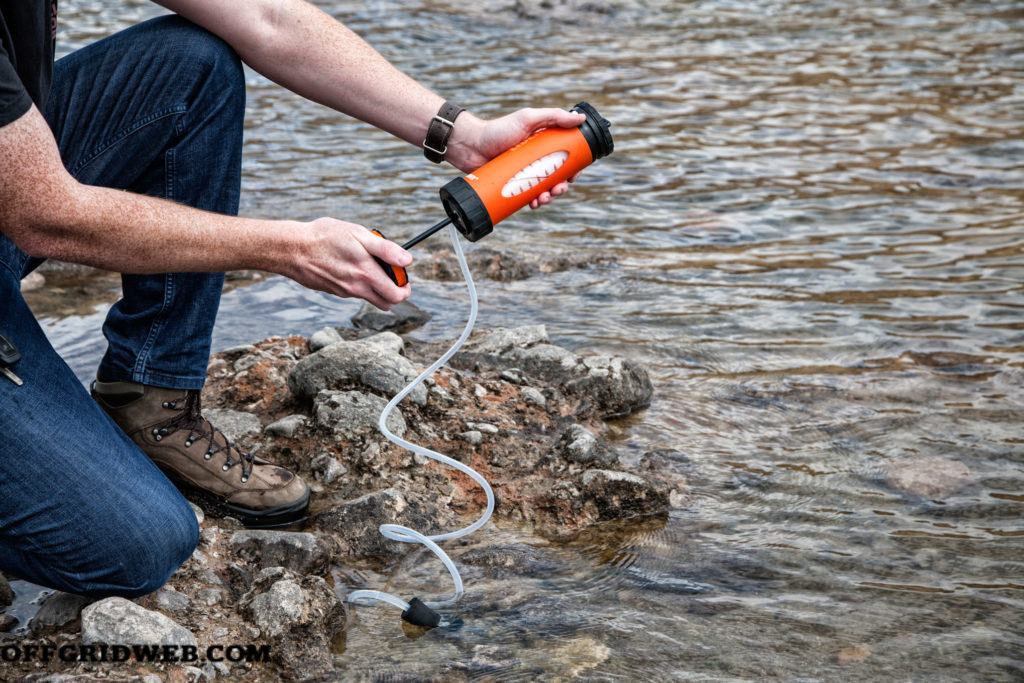 Attach scavenger hose to inlet on bottom cap. Place float in dirty water source. Open lid and water flow valve, then pump continuously to maintain flow rate.
Attach scavenger hose to inlet on bottom cap. Place float in dirty water source. Open lid and water flow valve, then pump continuously to maintain flow rate.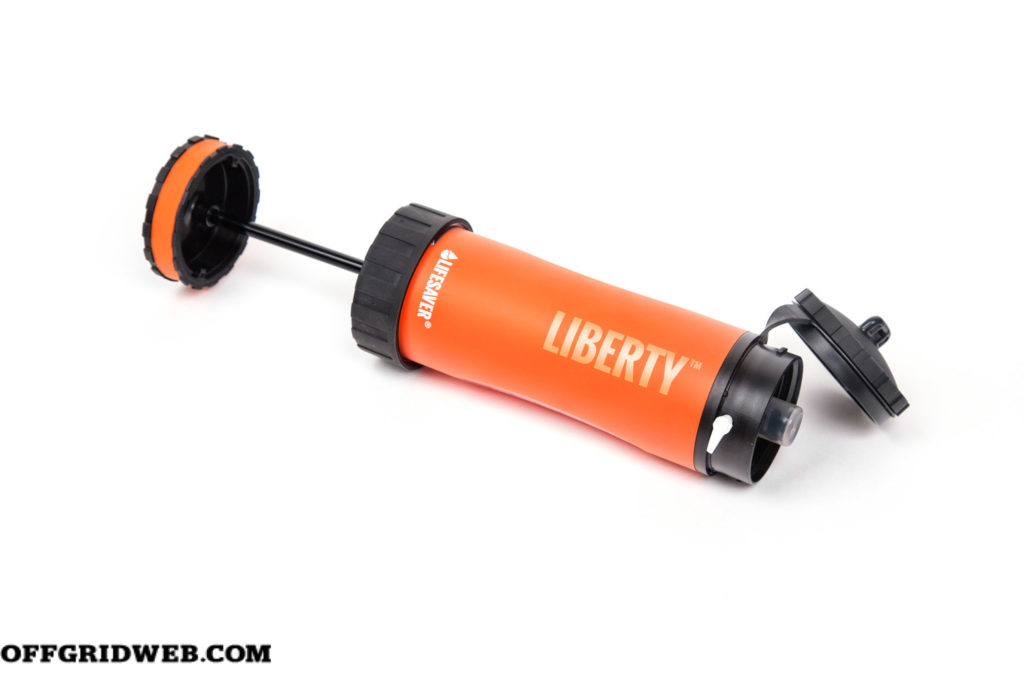
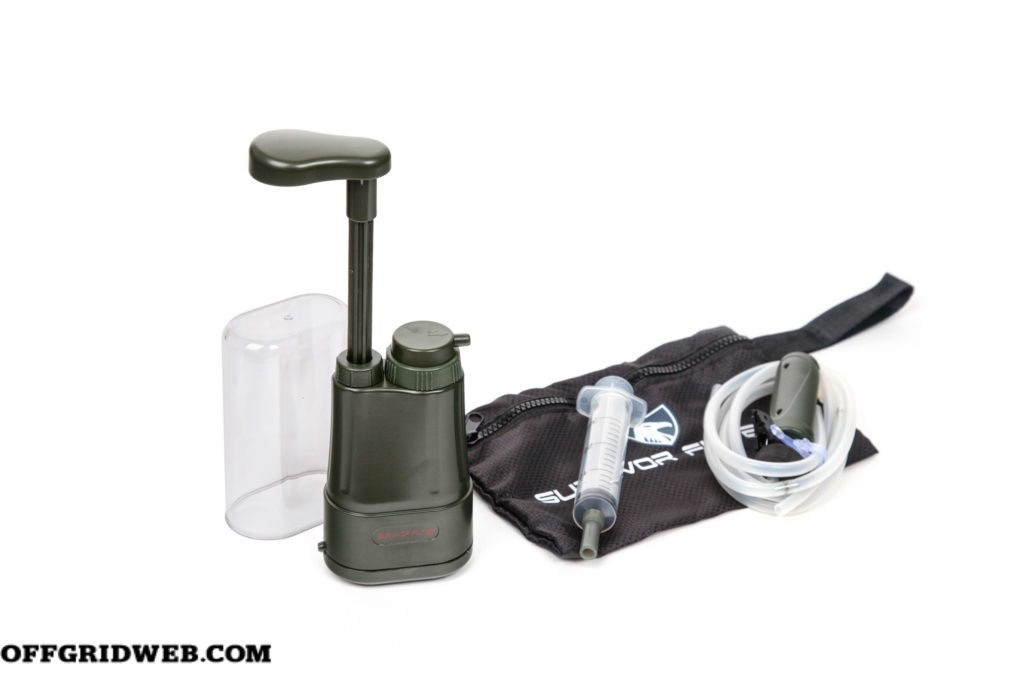
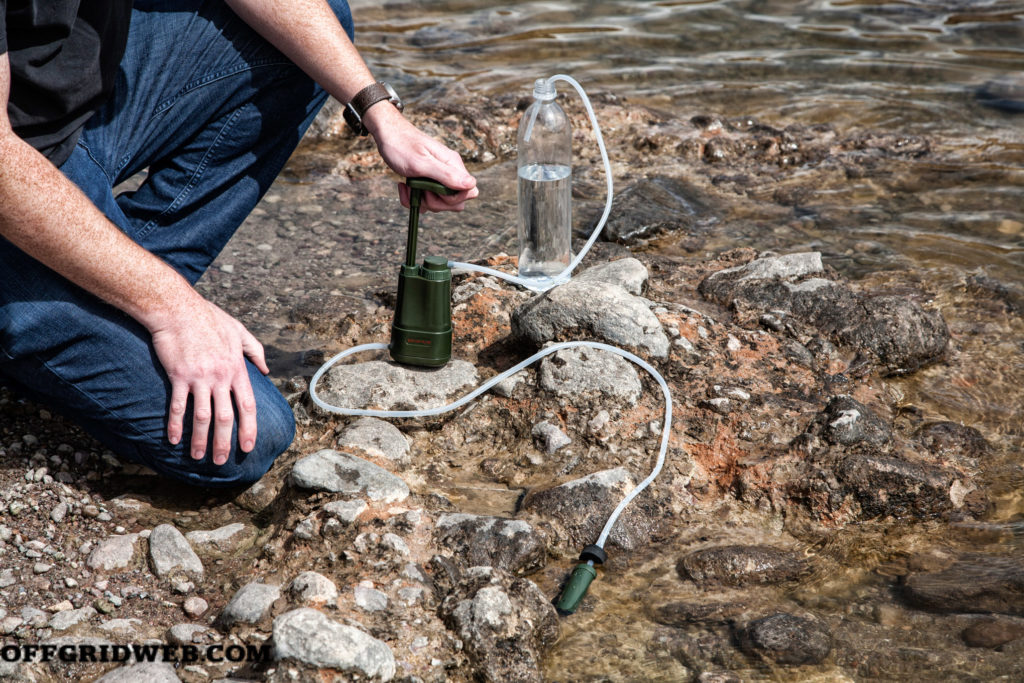 Connect inlet hose to lower nozzle, and place float in dirty water source. Remove clear plastic cap from unit and connect outlet hose to upper nozzle (marked “OUT”). Place end of outlet hose in the clear plastic cap, or a clean water reservoir of your choice, using the included clip to hold it in place if necessary. Pump handle to maintain flow rate.
Connect inlet hose to lower nozzle, and place float in dirty water source. Remove clear plastic cap from unit and connect outlet hose to upper nozzle (marked “OUT”). Place end of outlet hose in the clear plastic cap, or a clean water reservoir of your choice, using the included clip to hold it in place if necessary. Pump handle to maintain flow rate.